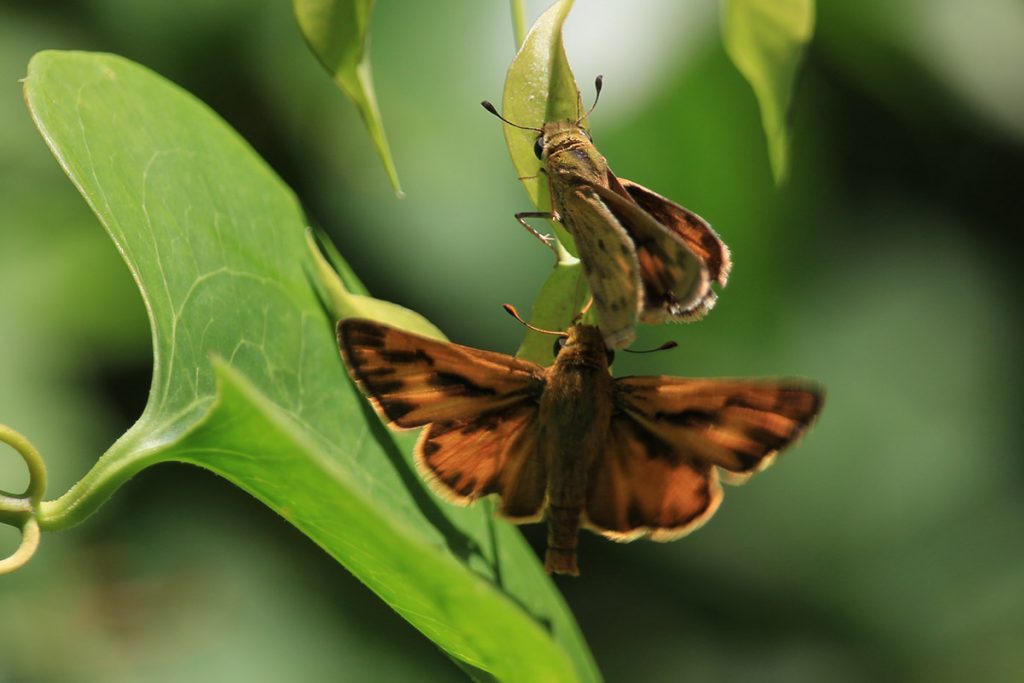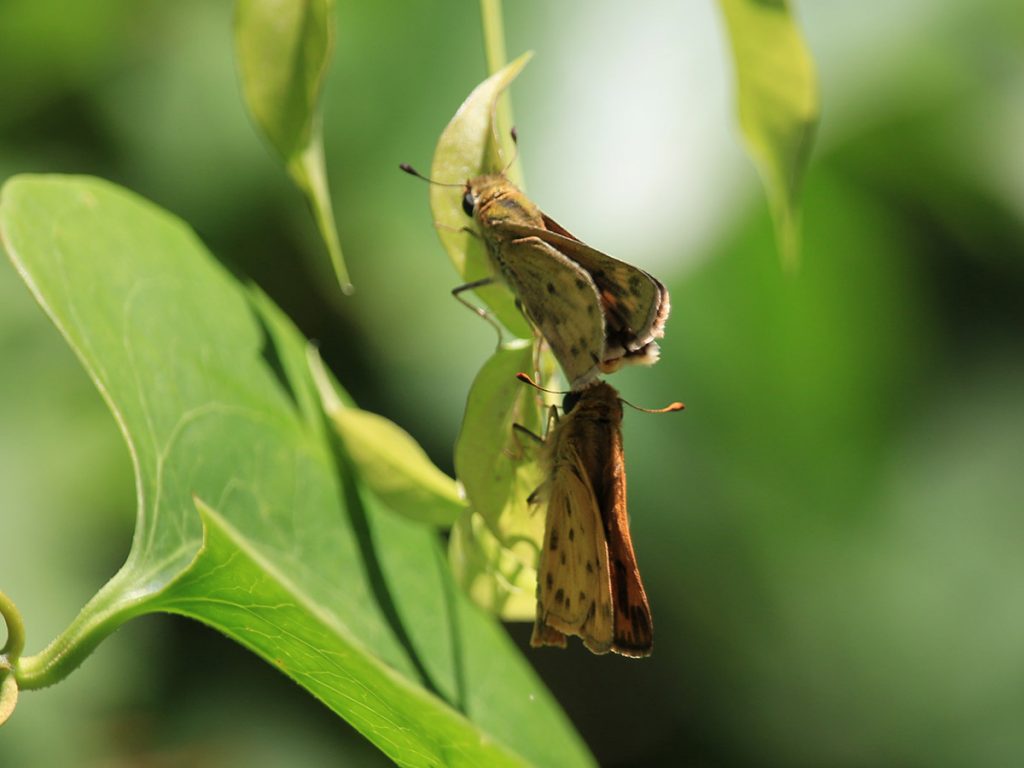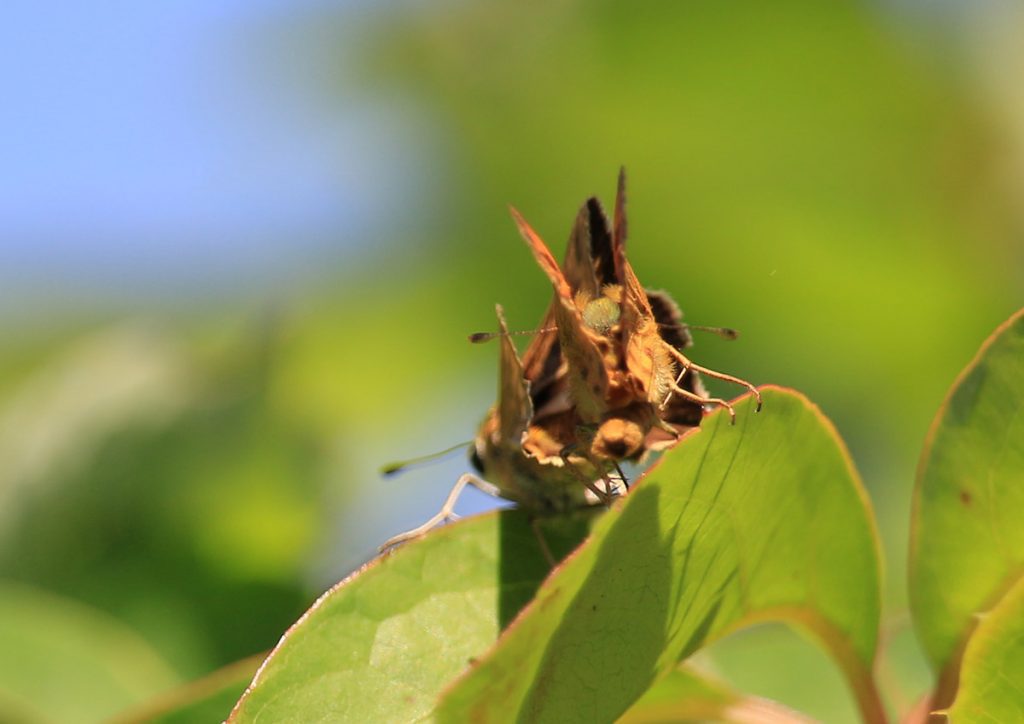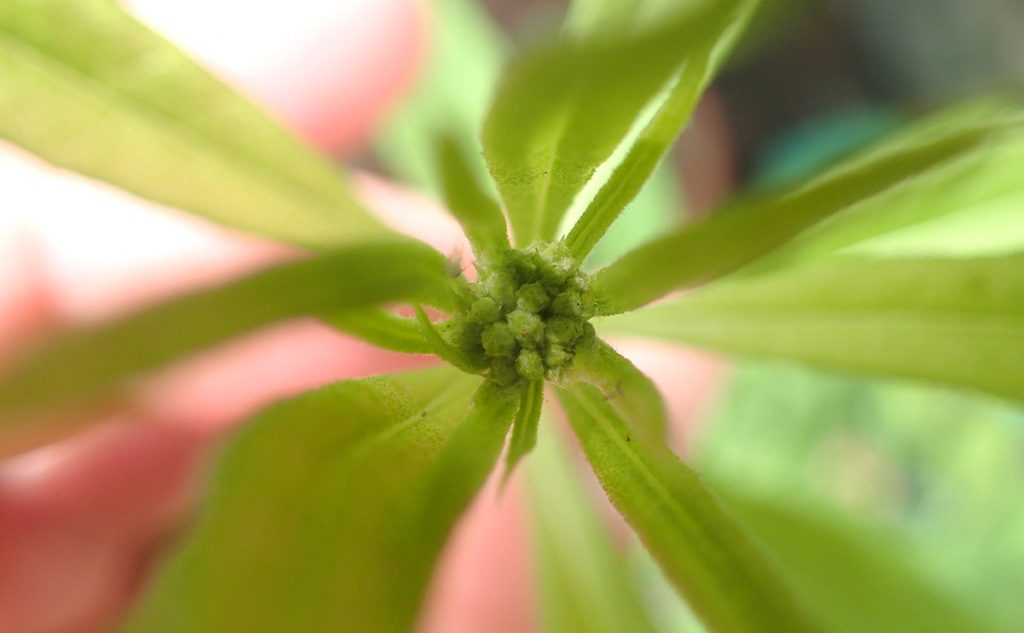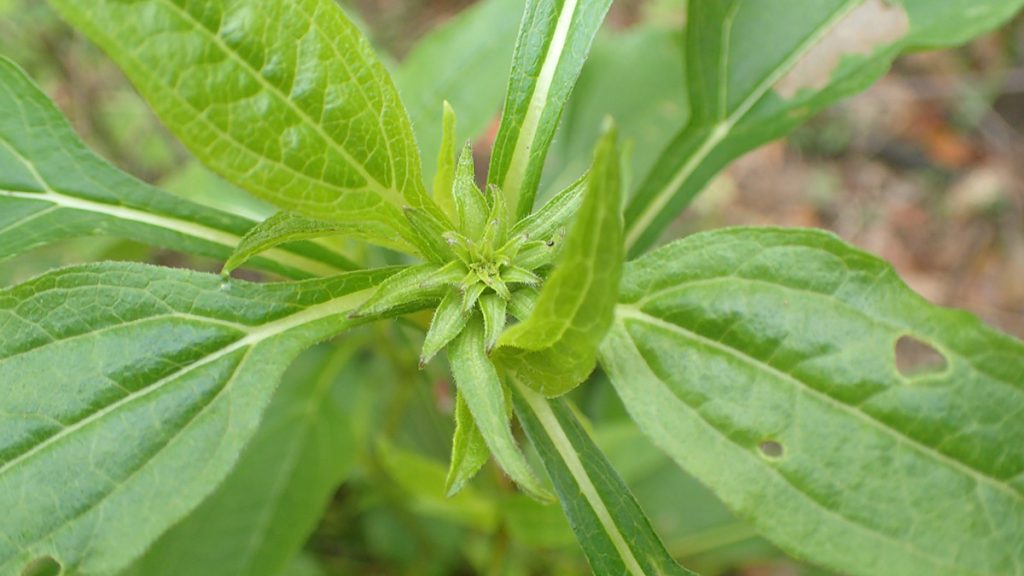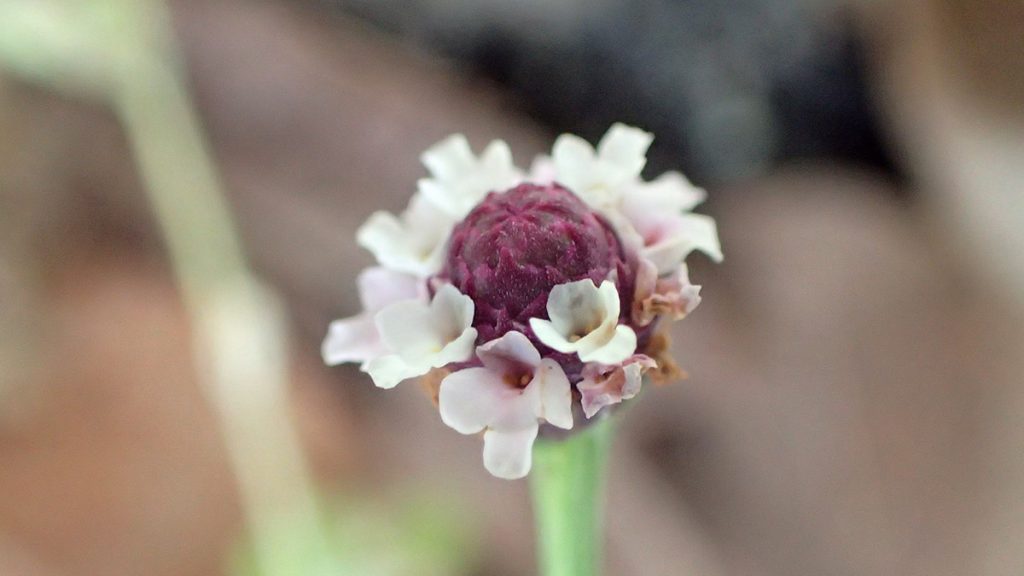Before I started writing this, I wanted to look back at the April 2019 Backyard Blog. I was barely home that month, as WFSU and its partners prepared for EcoCitizen Day on April 27. This April, like most of us, I barely left the house. I’ve been home at times when I’m normally at work, and so when I take a break from editing, I’m outside with a camera.
Needless to say, I’ve seen plenty. I feel in touch with my yard, perhaps more than I’ve ever been. I imagine quite a lot of us will have an altered relationship with our home spaces. Every flaw becomes amplified, but maybe we have the time to fix a few things, too. And we can appreciate the comforts we had taken for granted, from our favorite reading chairs to that patch of flowers about to explode.
There were plenty of butterflies, and a few different bees. With the extra time, I ended up seeing and identifying (or, in some cases, continuing to identify) a more diverse selection of wasps and flies than I expected. We’ll get to all of that.
Right now, I want to start with a single species of flower, a weed that is all over our yard. Any one plant is its own ecosystem, supporting a web of animals. In April, the smooth cat’s ear exemplified this.
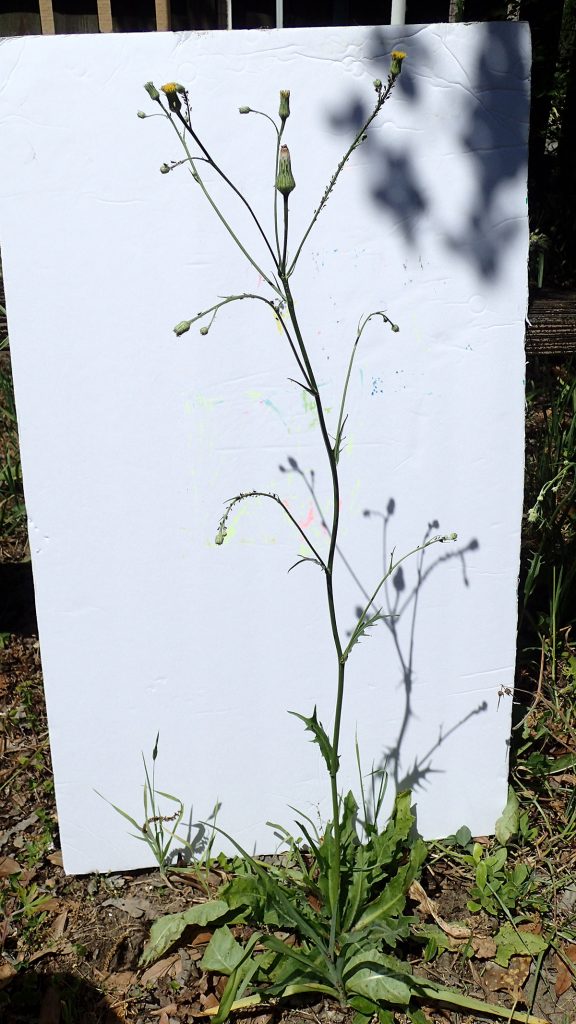
Smooth Cat’s Ear (Hypochaeris glabra)
Back in January, I photographed a few different clusters of leaves sprouting from the ground, and identified them in iNaturalist. These were all wildflowers, months before gracing us with flowers. In April, many of them popped.
After they did so, I revisited each of the species to confirm their initial identifications. When I googled smooth cat’s ear, I was frustrated by the photos I found of it flowering. The plant grows in clusters, and they can get dense. I didn’t see many pics that clearly showed me the stem of the plant, and its multiple flower heads. So I found this foam board in our study, and took a photo that let me get a good profile.
Even zoomed out to show the whole plant, you can see the silhouettes of insects near the flowers: aphids.
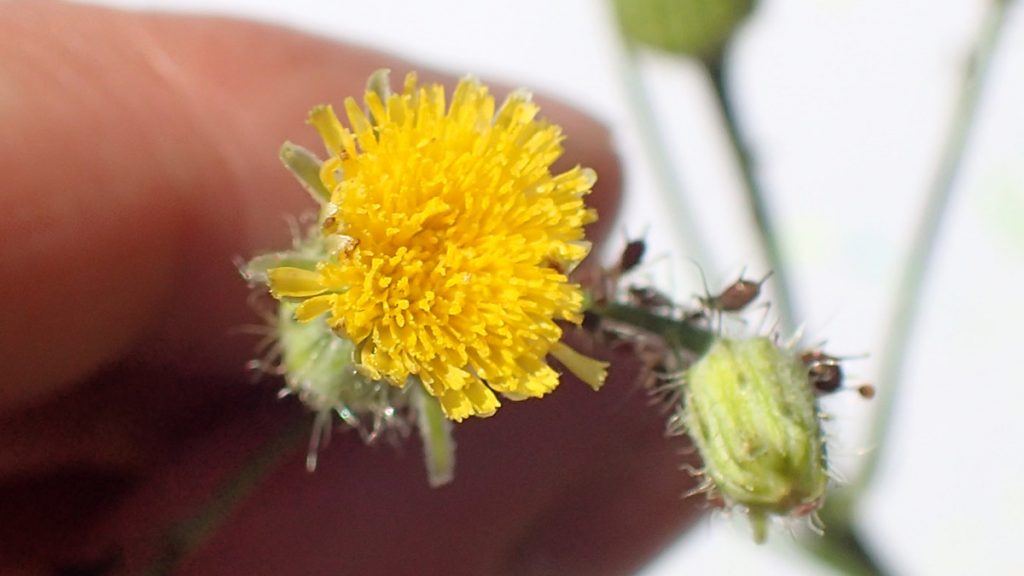
Insect life on smooth cat’s ear
Better to see them on these plants than on the plants I bought or raised from seed. I’ve been seeing plenty of hoverflies; and hoverfly (or syrphid) larvae eat aphids. But I never saw them on this nonnative dandelion relative. I did see ladybugs, though:
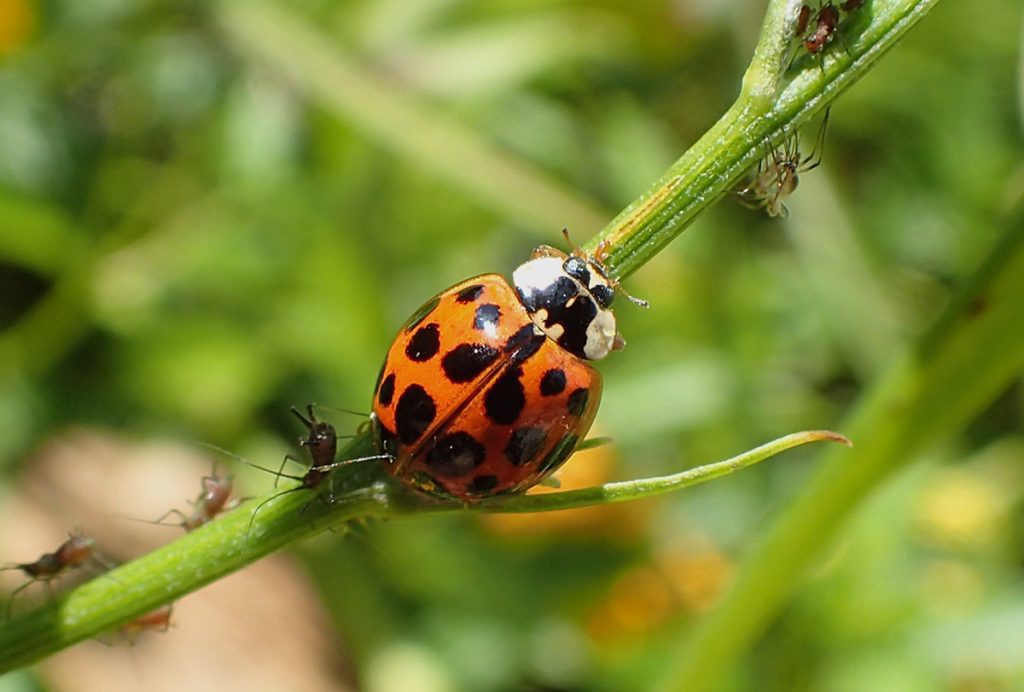
Another nonnative, performing a valuable service. I was curious, and so I searched Google to find out why I see so many of these, and never any native ladybug species. I read that Asian lady beetles were introduced into the United States to help control aphids. Unfortunately, it has several characteristics that have allowed it to rapidly spread and outcompete native species. They breed more often, and they eat other ladybugs.
So, they perform a service, but at what ecological cost? What happens when the many established relationships between native ladybugs and other plants and animals becomes disrupted?
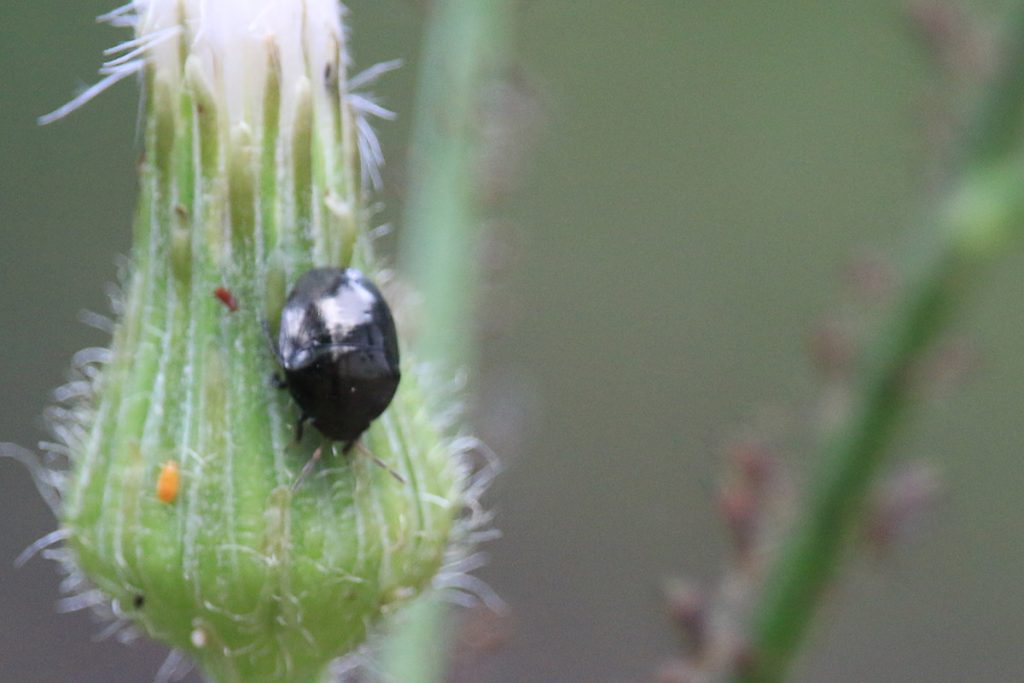
I was hoping the insect above was some sort of native lady beetle. Instead, it’s a plant eater. Ebony bugs eat flowers and flowers that are starting to go to seed, as we see above.
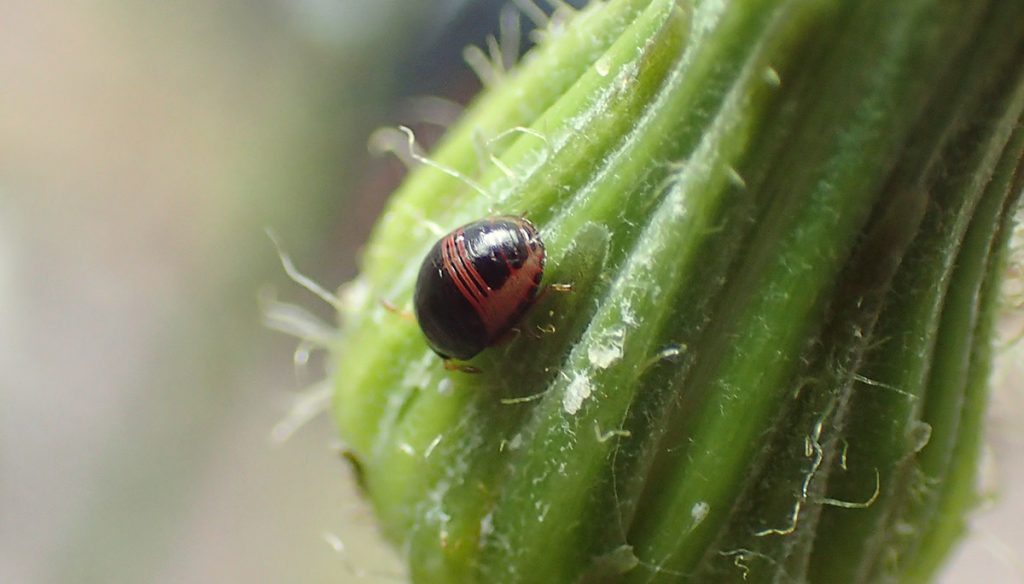
iNaturalist also suggested Corimelaena for this insect. Perhaps this is some juvenile stage of the first insect we saw?
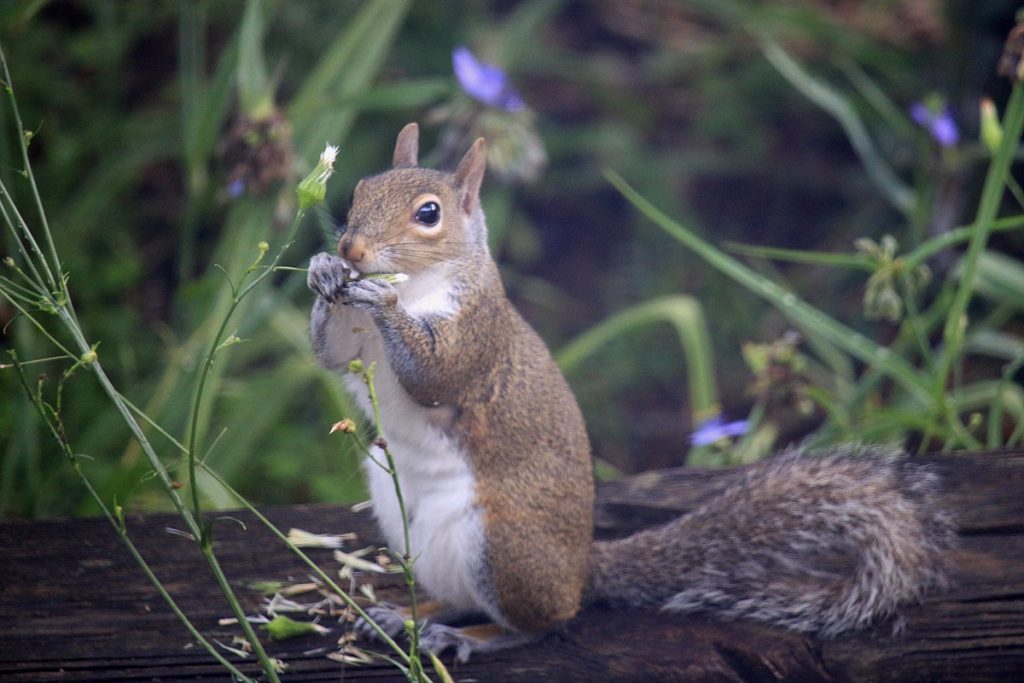
Lastly, I saw this out of my window one day. Last month, I photographed squirrels eating native geraniums as they went to seed. Seeding flowers feed birds and squirrels, and, yeah, insects too. It doesn’t keep squirrels from digging in pots where cherry laurel seeds fall, though.
Butterflies and Lantana
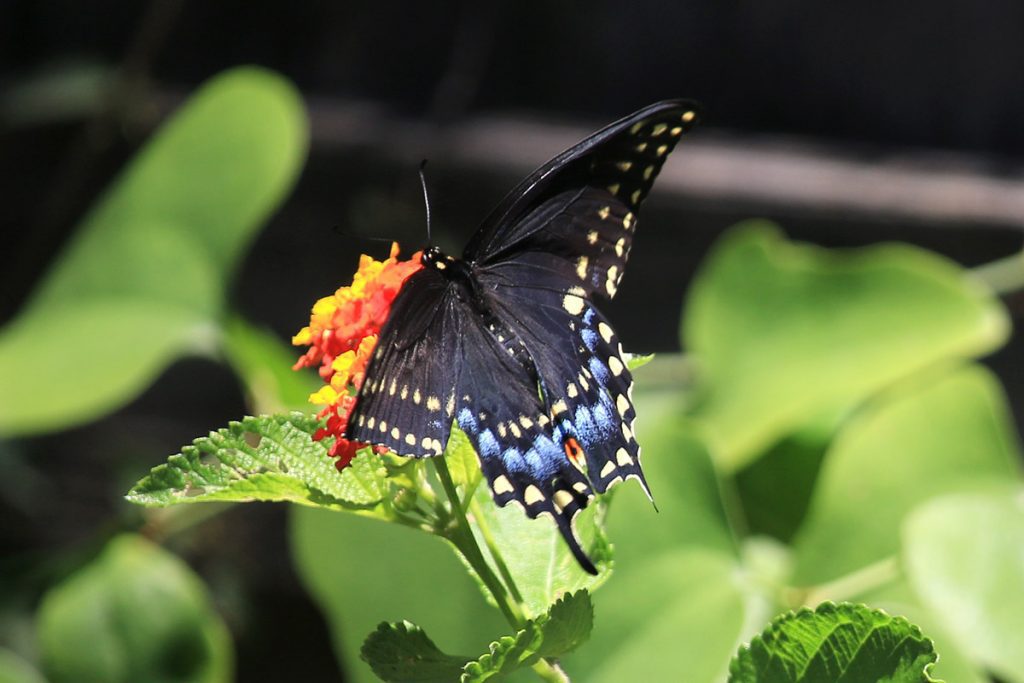
Here’s a flower that grows in four spots in the yard. It’s a plant I need to pull, but it’s hard to do when I see multiple butterflies on it. This is common lantana, which is native to the tropics. People buy it because it is so popular with pollinators. It also spreads easily, and becomes invasive. I had once bought a sterile lantana from Native Nurseries; the invaders, I think, came from a bush growing in a neighbor’s yard.
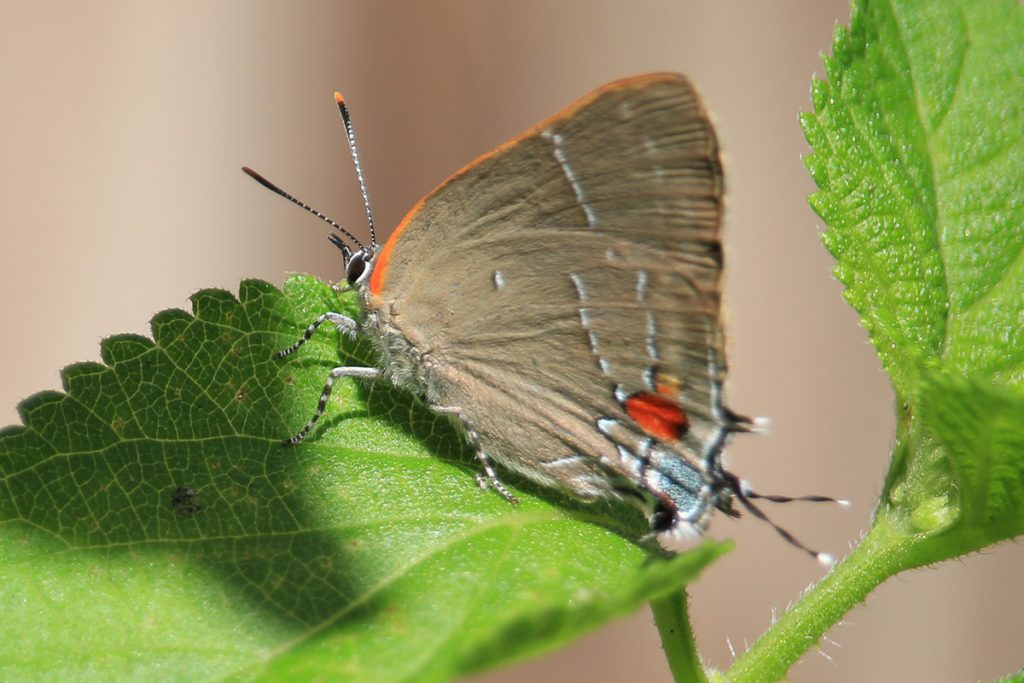
This hairstreak (one of two hairstreak species I spotted in the yard this month) isn’t nectaring on the plant; instead this wide leaf makes a nice spot to catch some sun. White m hairstreak caterpillars host on oaks.
The two butterflies above were on the same plant, which is growing behind our garbage can, from under the fence. At first, it felt like a little bonus nectar source where I don’t plant anything. But this plant will spread and start to crowd out other plants in the yard. A lot of other native flowers here are ready to bloom, maybe a little later than what I’m seeing elsewhere on social media (such is my yard). So, soon, I’ll have better nectar sources for our many pollinators. (Two days after I wrote this, I saw the flowers go to seed and I pulled it and bagged the seeds).
The Golden Lantana Bed
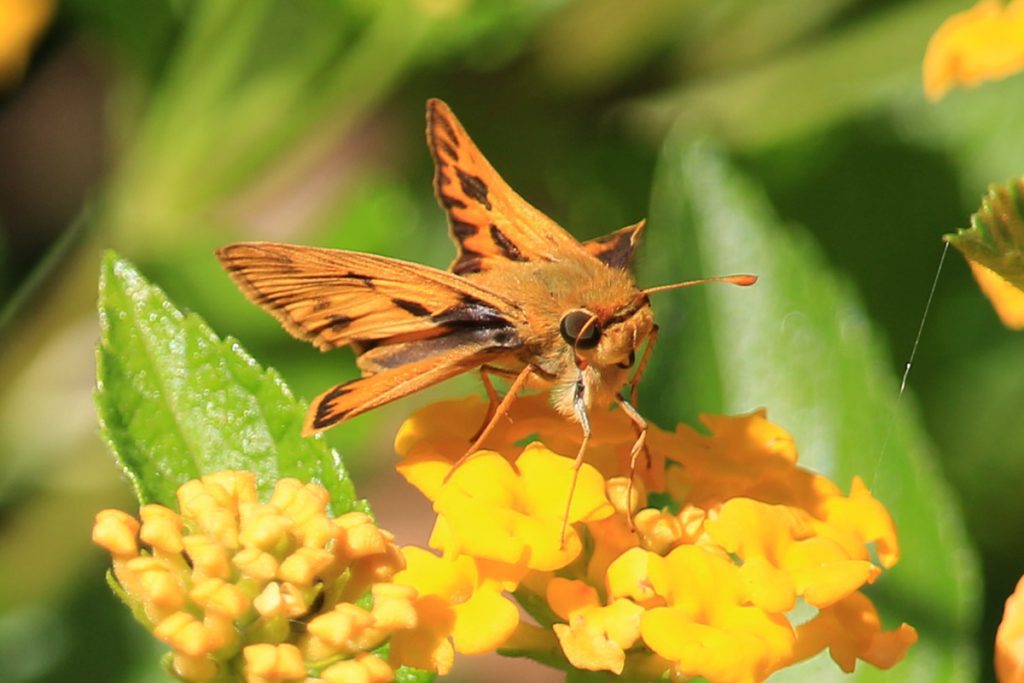
When we bought our house a little over a decade ago, it came with this bed of golden lantana. I think this is likely a hybrid, and a sterile one, as we’ve never had this pop up anywhere else.
Right now, it’s blooming like crazy. It likes it slightly on the dry side; I’ve notice prolonged rainy periods tend to wash its flowers away. But it has been moist enough to keep the plant flourishing.
Fiery skippers
Right now, we have about three fiery skippers that regularly take nectar from its flowers. Sometimes I see them fly off together, and sometimes two of them fight over the third. A couple of times, I saw one attempt to mate with another:
The male, I assume, gets close and tries to mate, only have the female fly away. I’ve seen this a couple of times. Here, the skippers have flown to a smilax vine growing on the fence adjacent to the lantana bed.
Fiery skipper caterpillars host on grasses. I’ve noticed some of the native panicgrasses growing in our yard have grazing damage. But I never see anything eating them during the day. I need to spend more time shining a light on certain plants at night, I think.
Horace’s Duskywing
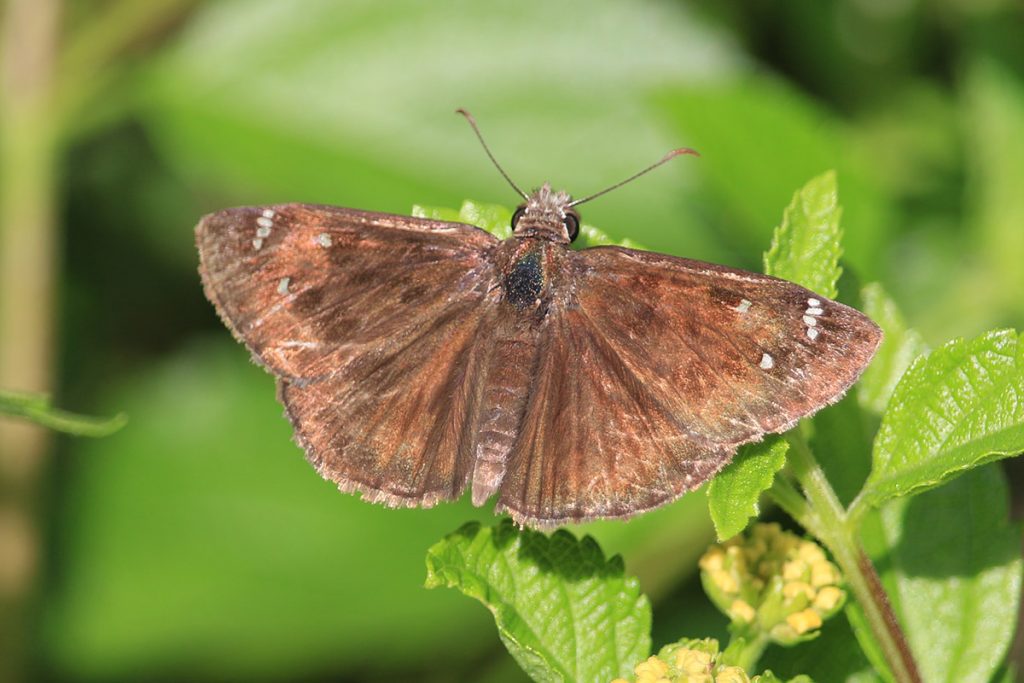
Looking back at last year’s Backyard Blog entries, I see that fiery skippers and Horace’s duskywings were the among the first butterflies I saw last year. Last year, I first spotted them in May, but as I mentioned, I wasn’t around much in April.
Horace’s duskywings host on oaks. During the colder months, their caterpillars hibernate, maybe high up in our laurel oak.
Texas Crescent
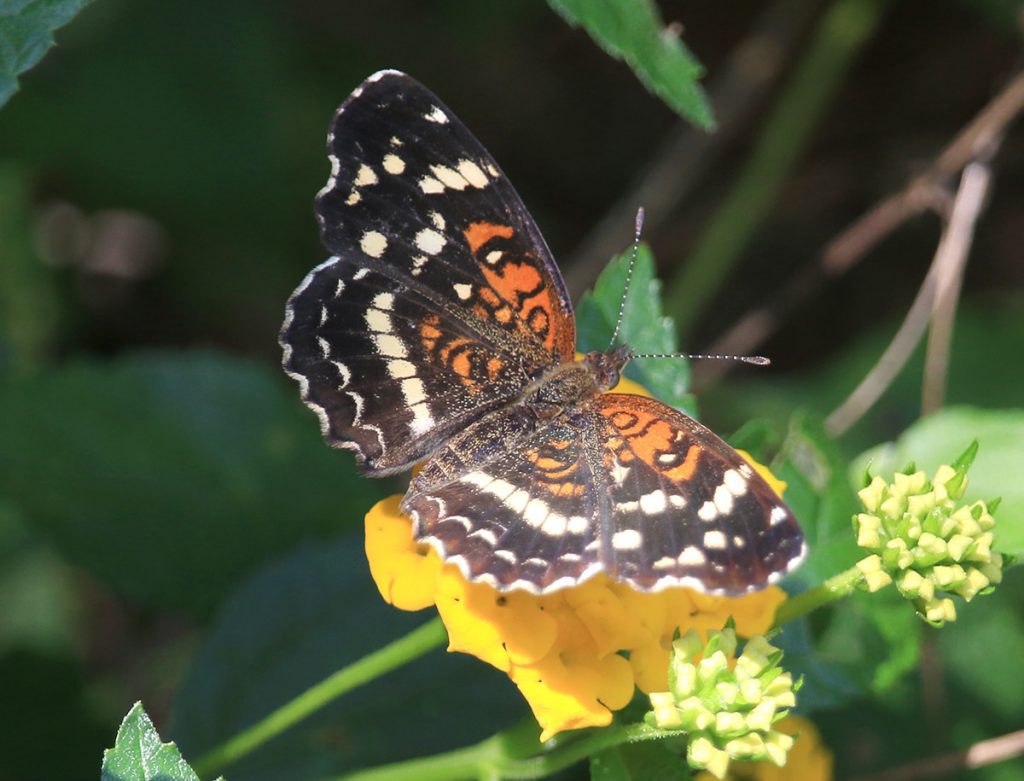
Here’s a butterfly I’ve never seen in the yard before. I don’t know crescents well, but I recognized this as one. I was hoping it was a phaon crescent, as the fog fruit I planted last year has been spreading. And phaon crescents host on fog fruit.
My butterfly guide lists this as a “Seminole” Texas crescent, which is a subspecies. I haven’t been able to find much about it, or what distinguishes it from a regular Texas crescent.
Silver spotted skipper
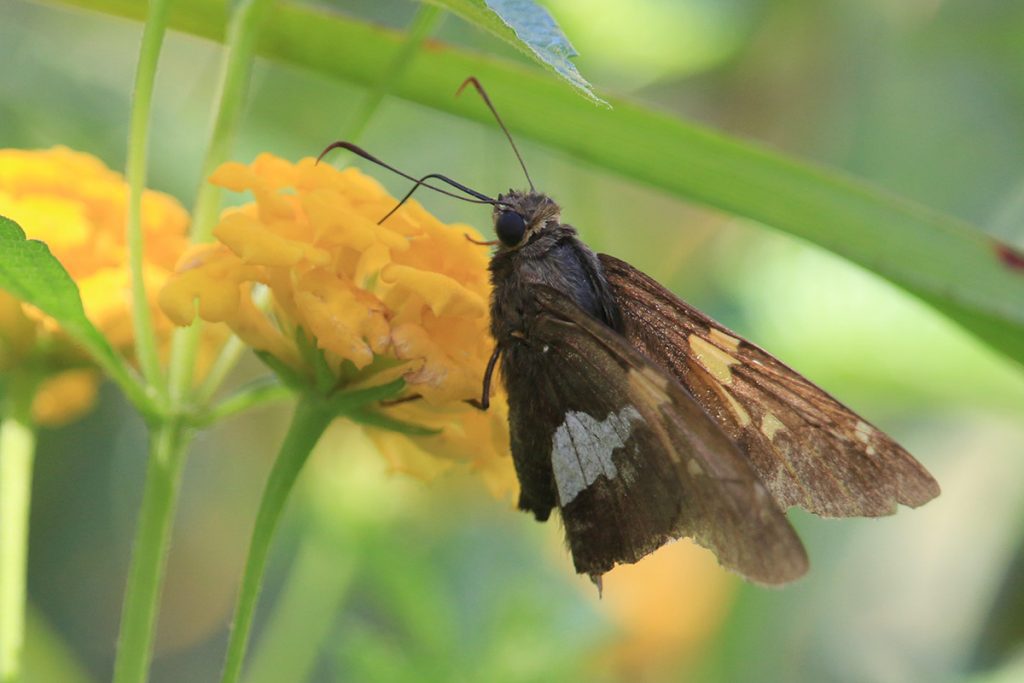
Here’s a butterfly I see once or twice a year in the garden. It was nectaring in a shady spot before it flew off. So it’s not the brightest photo.
I also spied a long-tailed skipper fluttering over the bed, but it passed right over me. It’s the only one I’ve seen so far this year, but my bean plants are starting to get a nice size. I checked them for eggs, but didn’t find any. Soon, I’ll see a fold on one of those leaves, and those butterflies will become the most seen species in our yard for a few months.
Other Insects on our Lantana
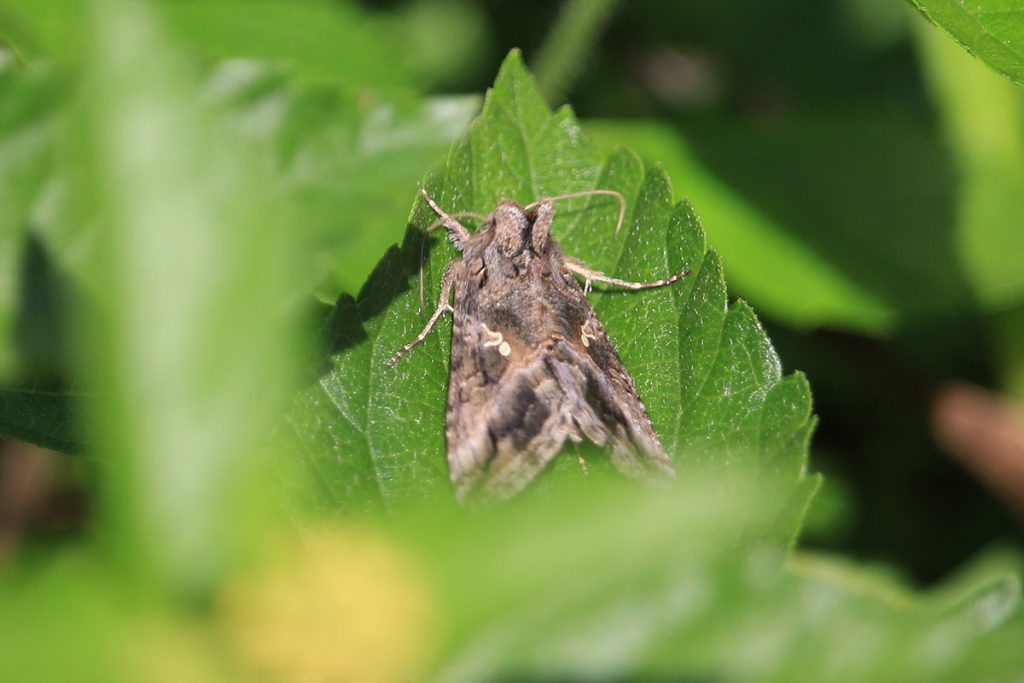
There might come a day when I get really good at identifying the many little brown moth species. Using the compare button in iNaturalist, I see that the white circle and squiggle on each wing matches the gray looper moth. The compare button lets you take a closer took at your identifications. Gray loopers hadn’t previously been identified in Leon County (which doesn’t mean they’re not here, just that no iNaturalist user had previously made this identification here). So I turned off the location filter, which let me see this species and compare photos, and feel fairly confident about my original ID.
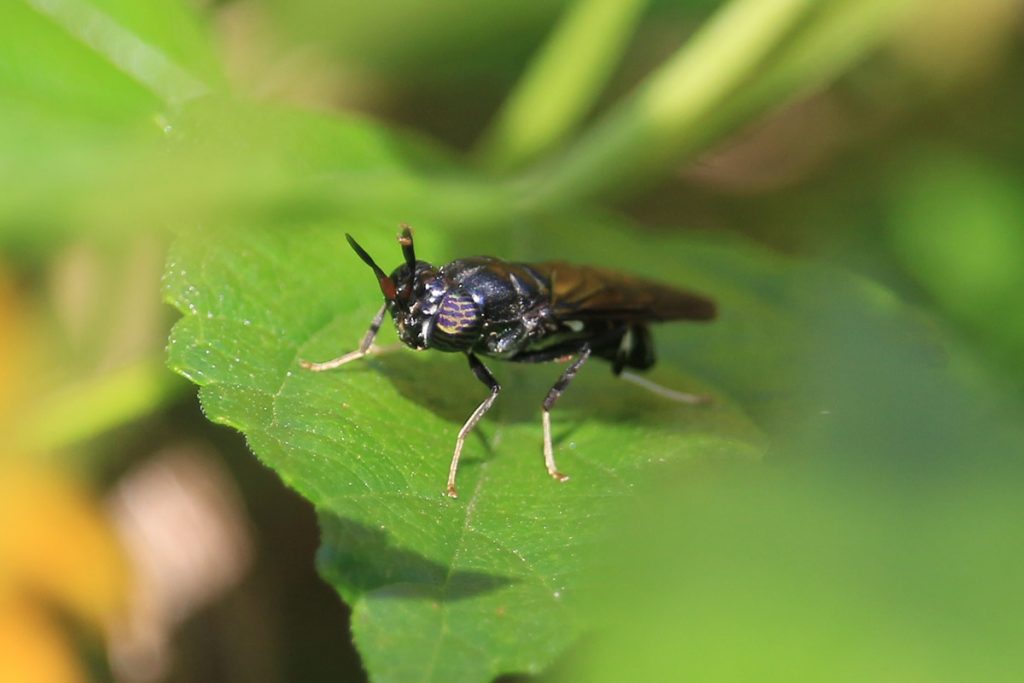
I thought this was a wasp, but instead this is a black soldier fly, a wasp mimic. Reading up on them, I see they’re considered beneficial insects. They’re not pollinators, and they don’t eat pest species. Their larvae, however, help decompose compost.
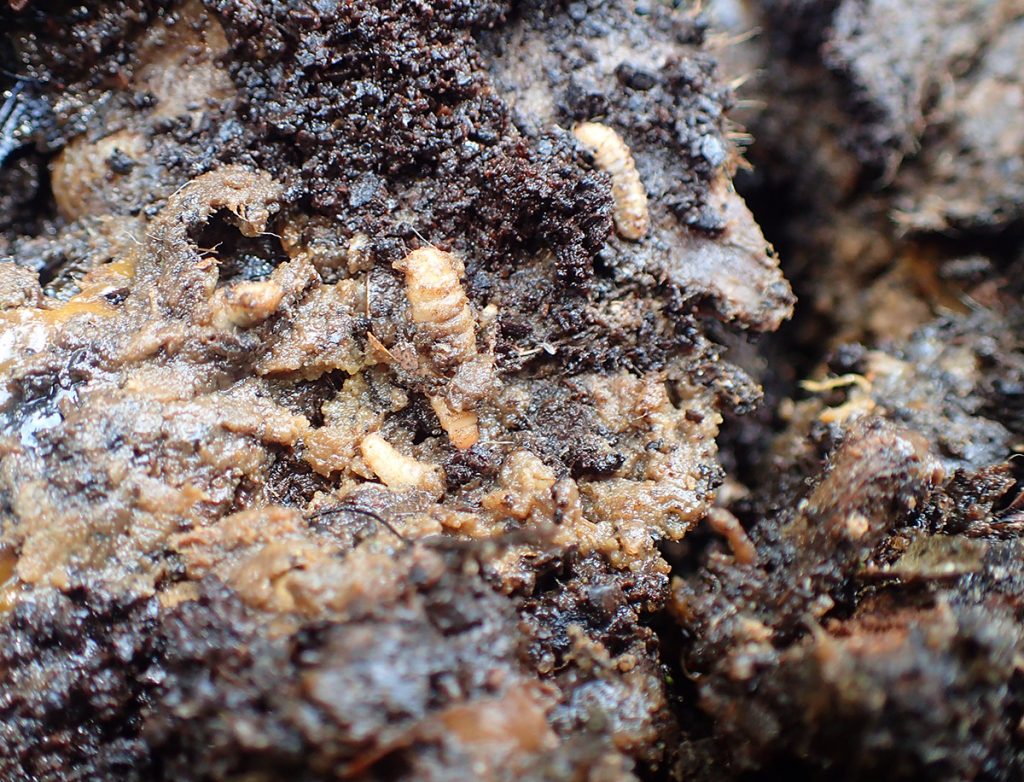
I stuck a shovel into our compost, and there are a lot of insects breaking it down. Those white grubs do look like the photos of black soldier fly larvae. There are a lot of different insects that help break down decomposing plant matter, from the leaves dropped by trees onto your yard to the combination of fruit and veggie scraps I mix with leaves and moss in our compost bin. Here’s a little video of my compost critters in action. It was a chilly morning, so I even got a little steam when I dug in (you can see it in the fourth shot).
Conversely, that decomposing plant matter, the leaves we might rake and bag, are necessary for many species of insects to survive, usually as larvae. This include fireflies, lovebugs, and even a few moth and butterfly species. If you can bear to let them lie where they fall, you’re doing your backyard ecosystem a favor.
Here’s another look at an adult black soldier fly that was resting on a paved part of the yard:
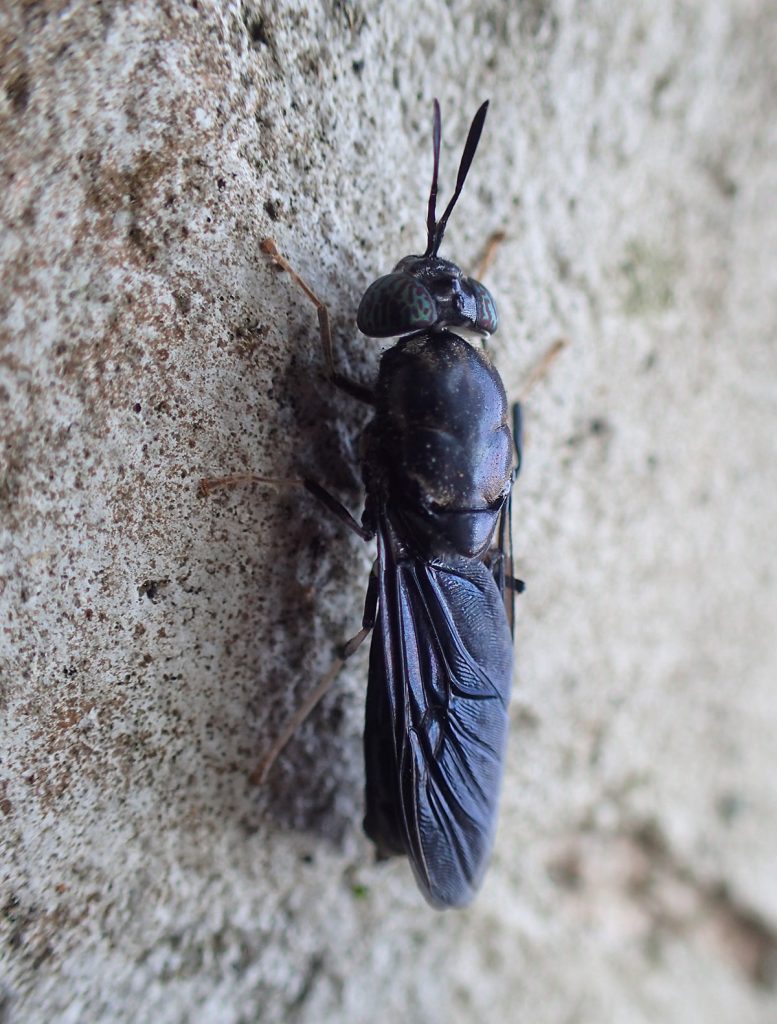
Caterpillars I Found Doing Yard Work
Most of our yard is paved, and though I like to leaves lie where they fall, Amy has other ideas. In the end, I’m glad she had the boys and I clear out the largest paved part of the yard. It does look nicer, and we are spending so much more time there now.
In the course of working on this part of the yard, I found a couple of caterpillars that must have wandered from their nearby larval host trees. Being as large as they were, they may have been looking for a spot to make cocoons.
I found this guy raking leaves:
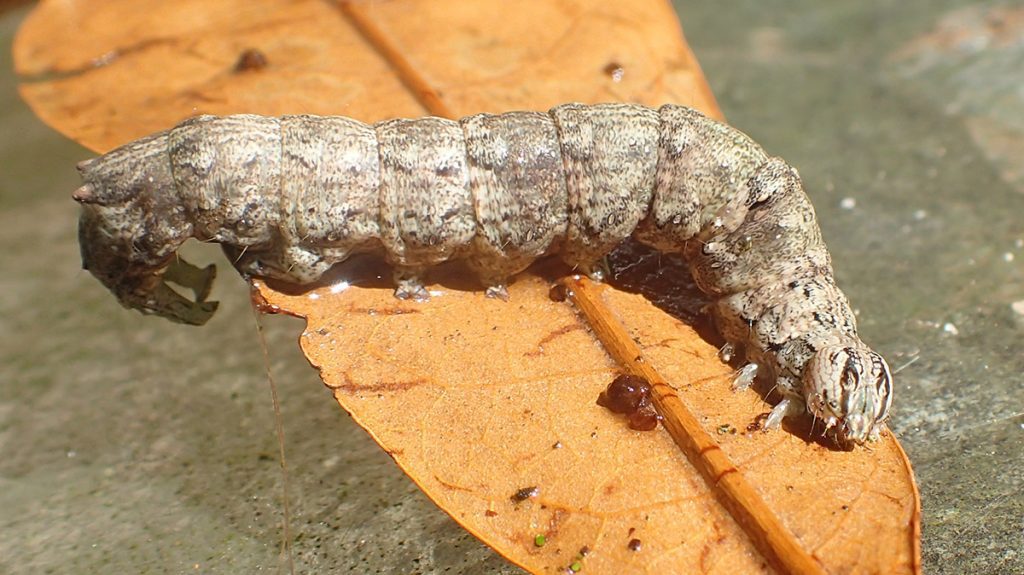
I found one of these in January 2019. That caterpillar’s markings were different, but if you Google image search “ilia underwing,” you’ll see that they have a variety of patterns. The patterns all blend in with tree bark. They eat oak leaves.
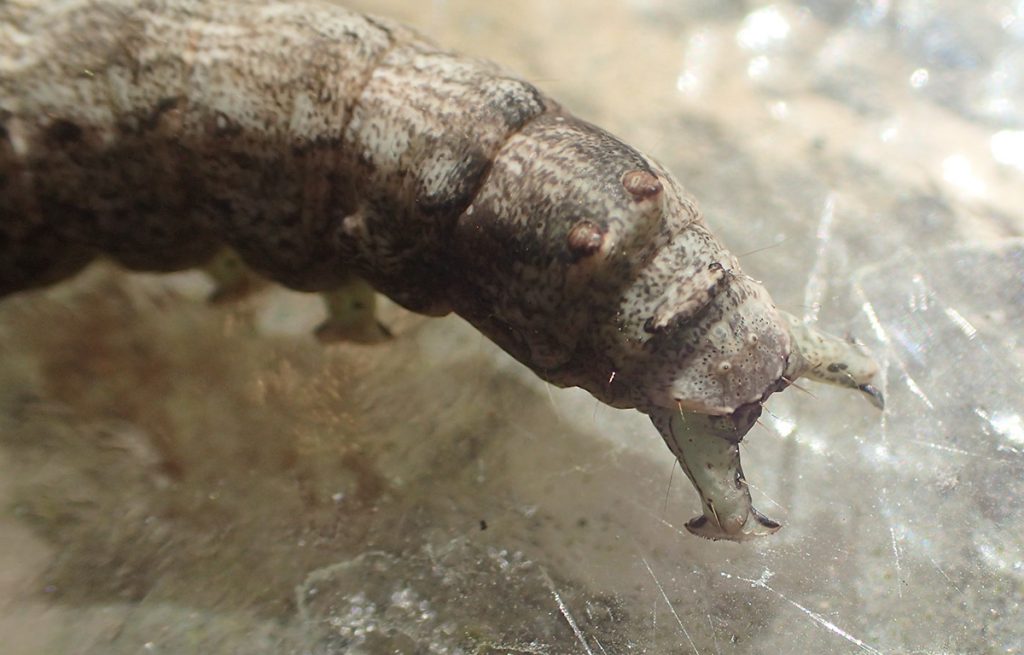
This is the backside of an ilia underwing caterpillar. I think it must use this to clasp the base of a leaf while it eats the tips. But I can’t say for sure, and I didn’t find anything in my searches. I used to think those were its mandibles, until I photographed its head:
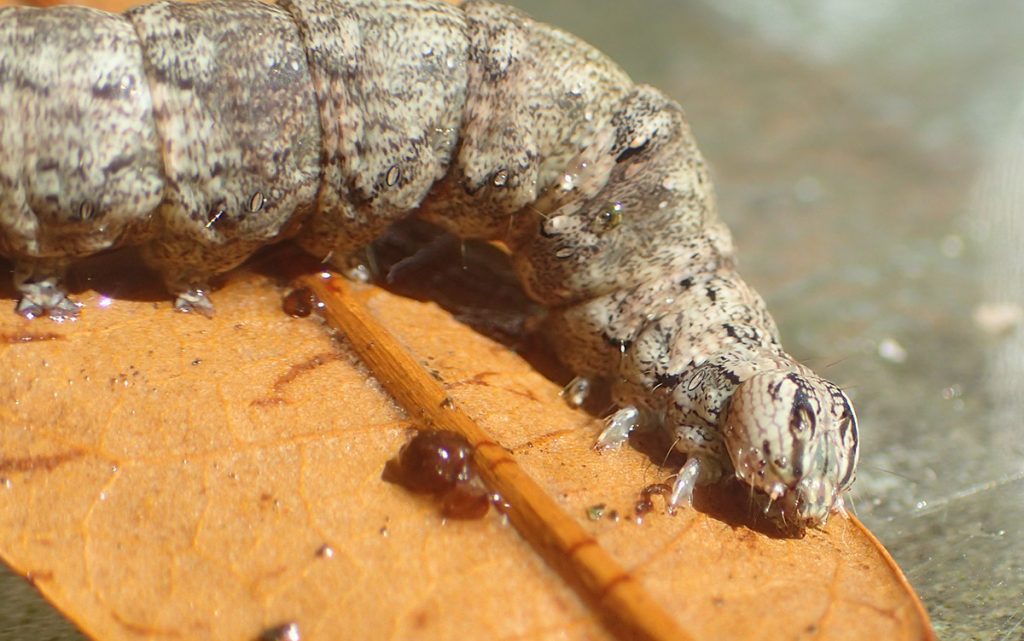
I found the caterpillar below in a compost bucket I’d left out.
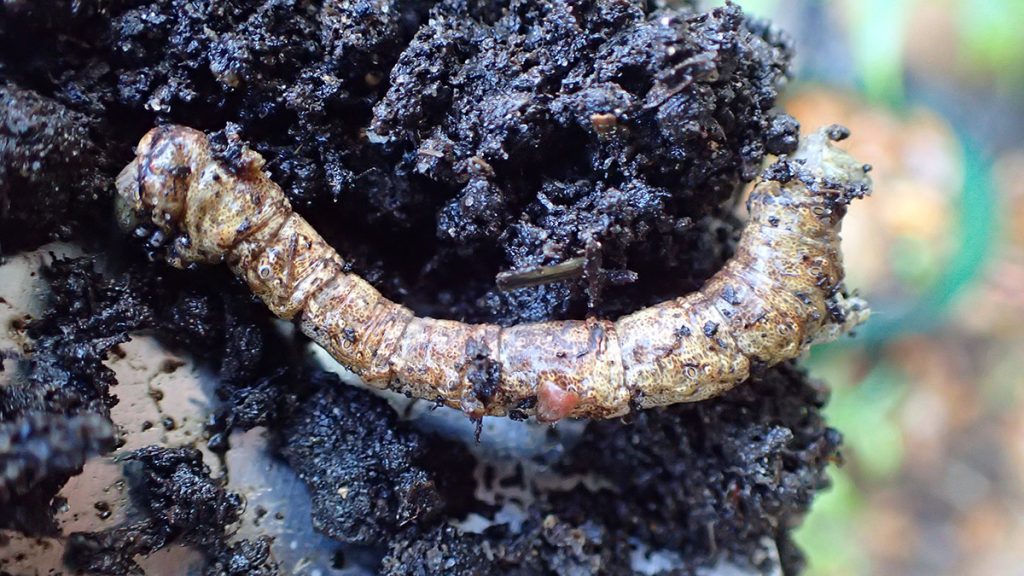
With a name like that, you’d think it also hosted on oaks. But the name has more to do with the patterns on an adult’s wings. In iNaturalist, you can click on your identification to get more information about the species. Here, I read that it hosts on a few different hardwood trees, including those of the Prunus genus. These are cherry trees, and we have Carolina laurel cherry trees all around the house.
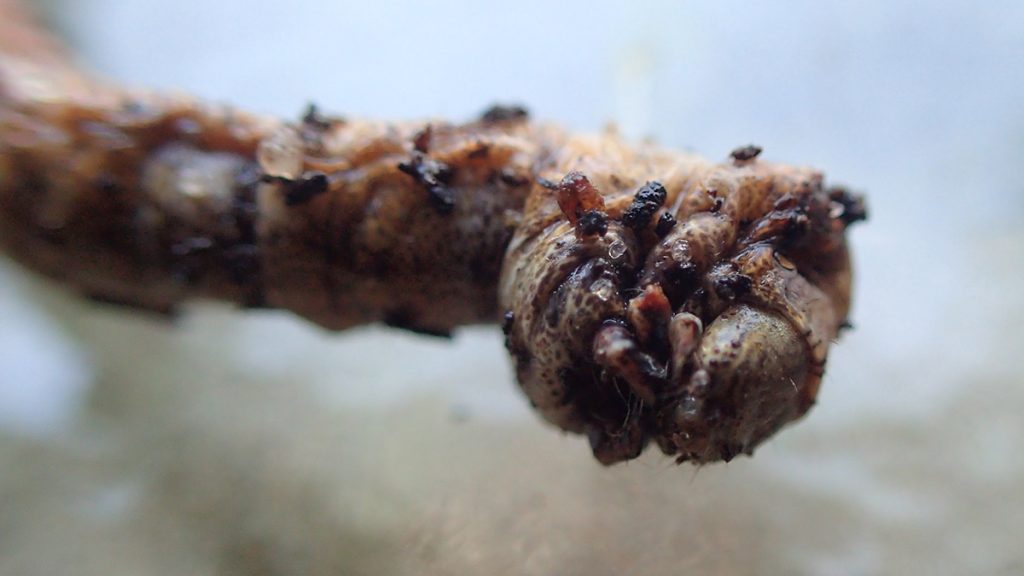
Pollinators Part 1: Butterflies not on the Lantana
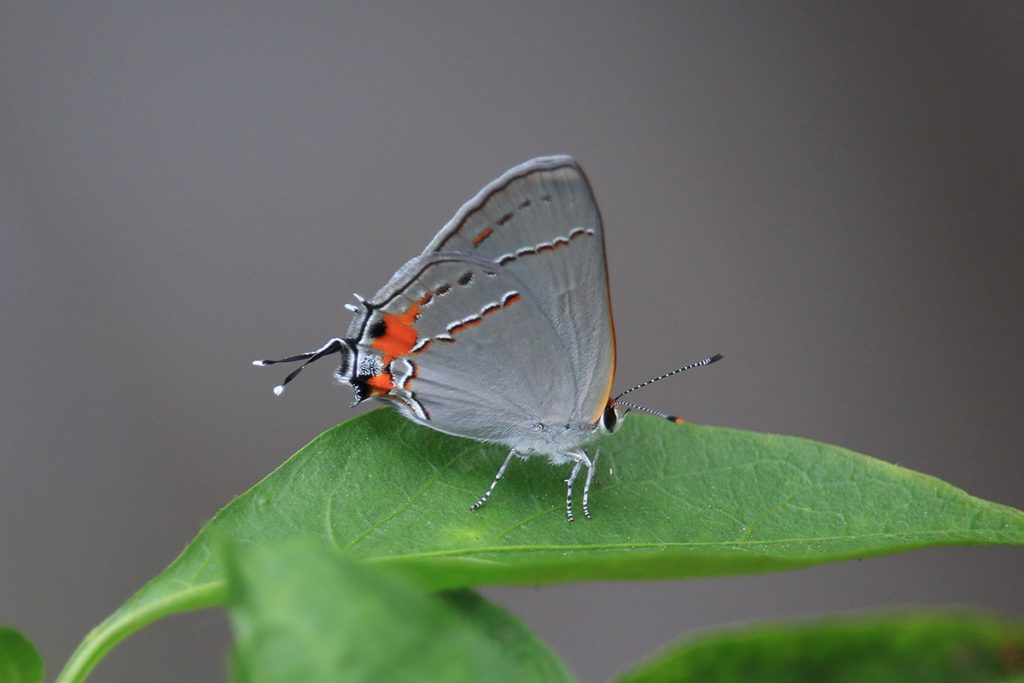
I found this little guy fluttering around one of our bell pepper plants, coming to rest on this leaf. They host on legumes and beans. I’ve seen a few holes on our young bean plant leaves, but not the folds associated with long-tailed skippers. I’m also letting a lot of common vetch grow in the yard. Legumes, after all, are nitrogen fixers, enriching the soil by converting nitrogen in the atmosphere into something plants can use.
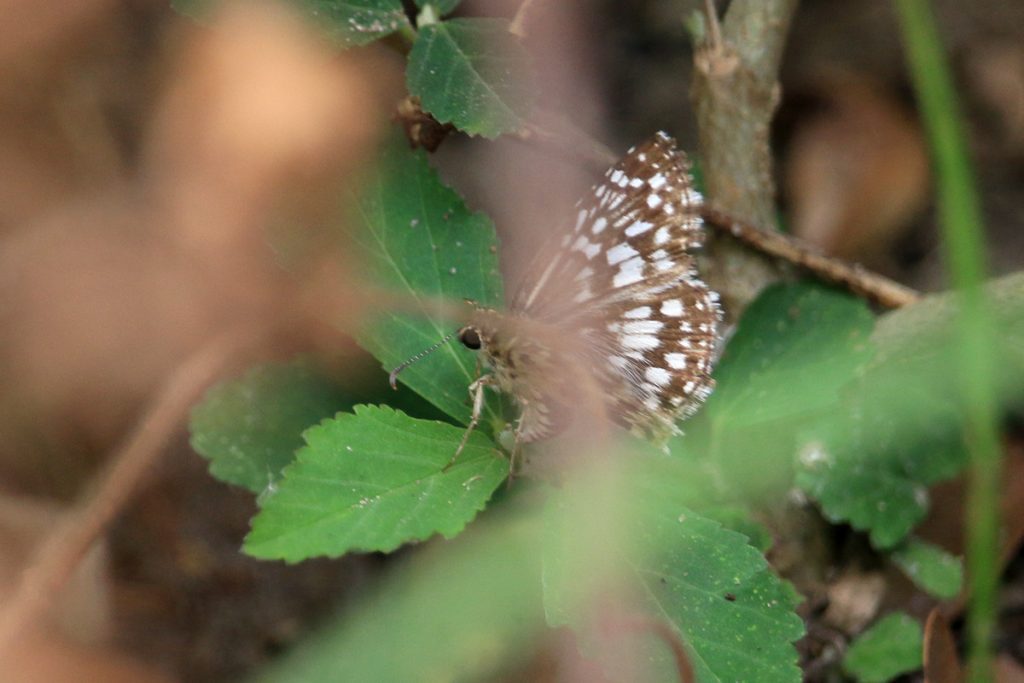
And then there are other larval host plants we don’t buy in stores. I’ve written a little bit about fanpetals. They’re a favorite weed, though they get bushier and woodier than a dandelion. The tropical checkered skipper above was flying down into the sheltered leaves, avoiding the exterior of the plant. I didn’t notice until after I snapped the photo that it was curling its abdomen, as if laying eggs.
This is its larval host plant. But I’ve never seen caterpillars on them, despite having over a dozen plants in the yard. However:
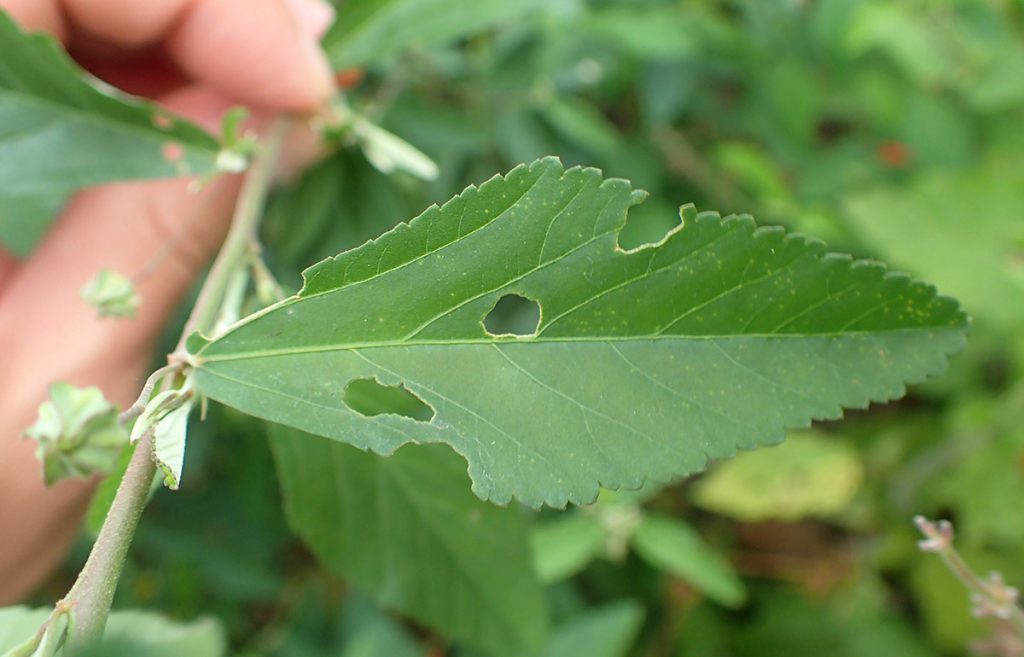
I keep seeing these butterflies in the yard, and around the fanpetals. Their presence over time suggests that some of these might have hosted here. So I’ll keep looking.
Pollinators Part 2: Bees
Not much on this front. Last year, July and August were our peak bee months. I did briefly see a bumblebee fly through, and a carpenter bee is often making its way through the yard, even if it doesn’t stop to gather pollen. The flowers they and many other bee species like are close to blooming.
That doesn’t mean they’re not in the yard. There are holes all over any bare patch of soil, and I occasionally see a small shiny bee like insect scurry under some leaves or even into a crack between pavers:
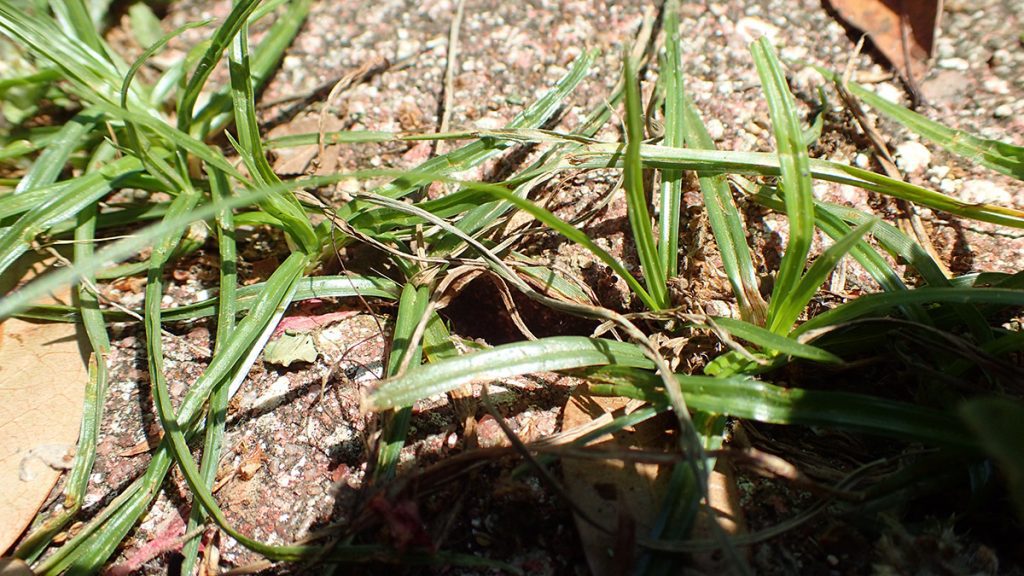
We may see more of them in the yard once the “good” flowers start to bloom.
Western honeybees (Apis mellifera)
Two flowers that have been plentiful in our yard are Ohio spiderwort and red salvia. The spiderwort is a native plant that I allow to proliferate in our yard. The red salvia started as two plants I bought. They have seeded multiple times in the last couple of years, and we now have dozens of them.
In March, a small number of honeybees (which I’m obliged to mention once per post are not native) were loving the spiderwort. More recently, they’ve taken a liking to the salvia as well:
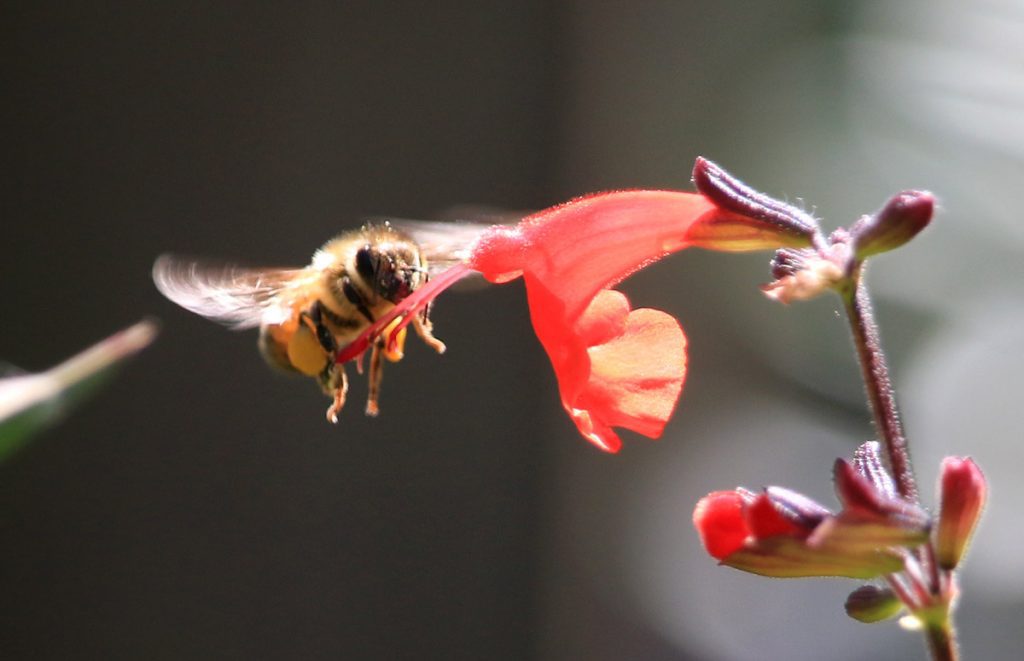
Small Metallic Sweat Bees
Sometimes we don’t see native bee species in our yard because most of them are just so small. Some species of metallic sweat bees are brightly colored, and so are easier to spot, especially on flowers of contrasting color. But sometimes, you have took really closely to see that you’re even looking at a bee:
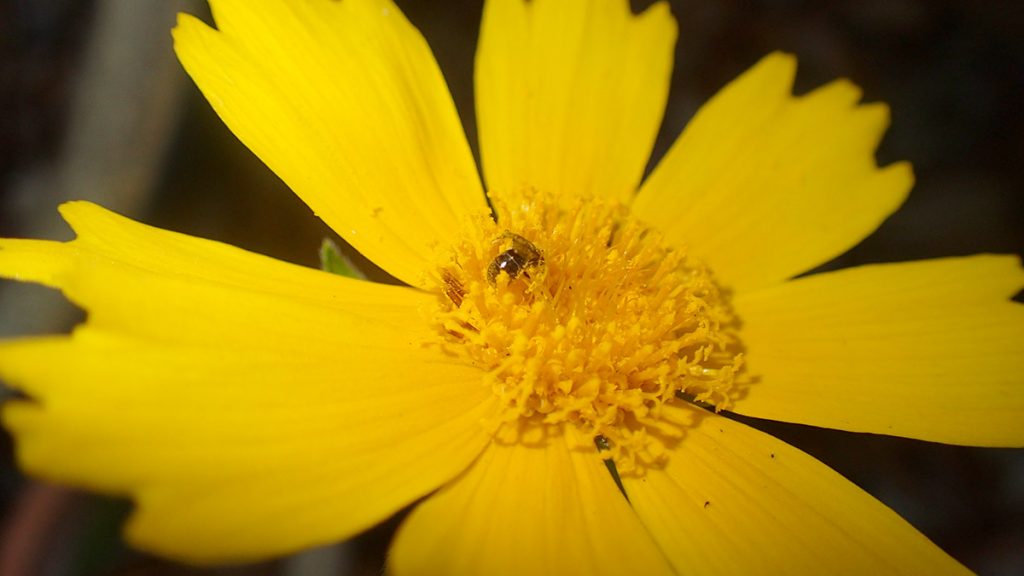
This lance-leafed coreopsis flower took forever to pop from its bud. The night after it did, we were having dinner in the back yard when I saw this speck moving among its stamens. It’s been nice out, so we’re eating in the yard more. Our table is by a lot of our plants, and so I usually bring a camera out and am always scanning.
Here’s a closer look:
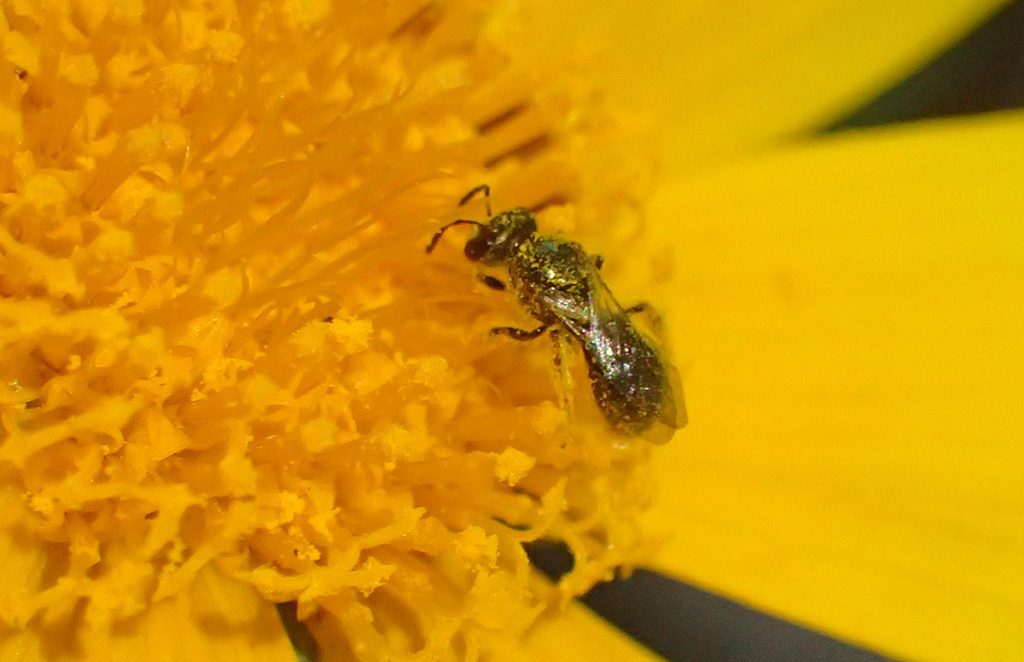
The best I ever get for these bees in iNaturalist is the genius Lasioglossum, subgenus Dialictus. I read about this subgenus on Bugguide; it says that to distinguish any of its hundreds of species, you’d need a microscope. So we may have a few species in our yard- or just the one.
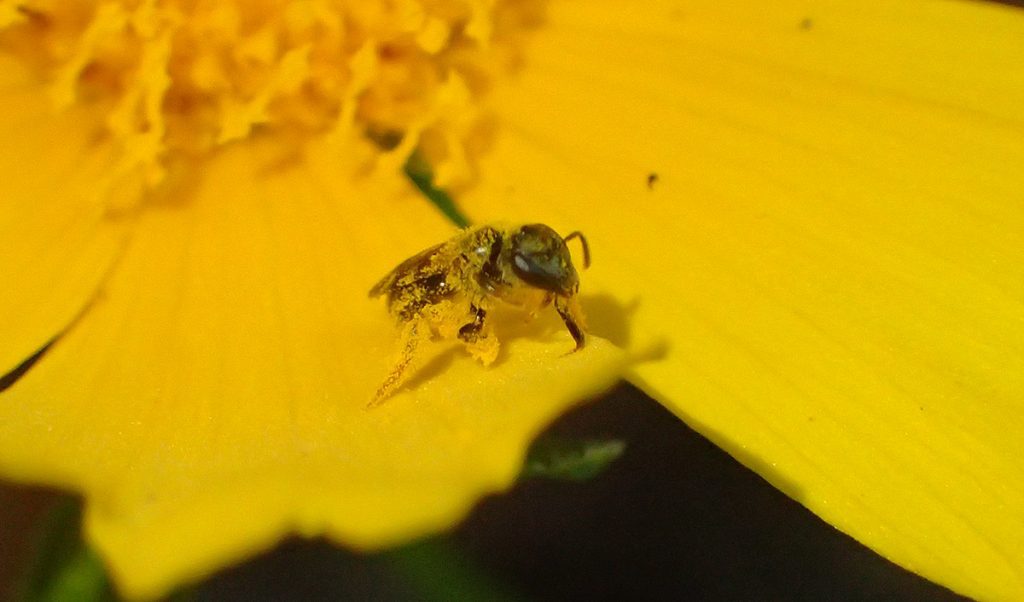
Pollinators Part 3: Wasps
While I may have to wait to see more bees in the yard, I can content myself with the fact that we’ll always have plenty of wasp diversity. Wasps can be hard to love. But, as we see, they serve many roles in our backyard ecosystems as pollinators and predators.
Humped Beewolf
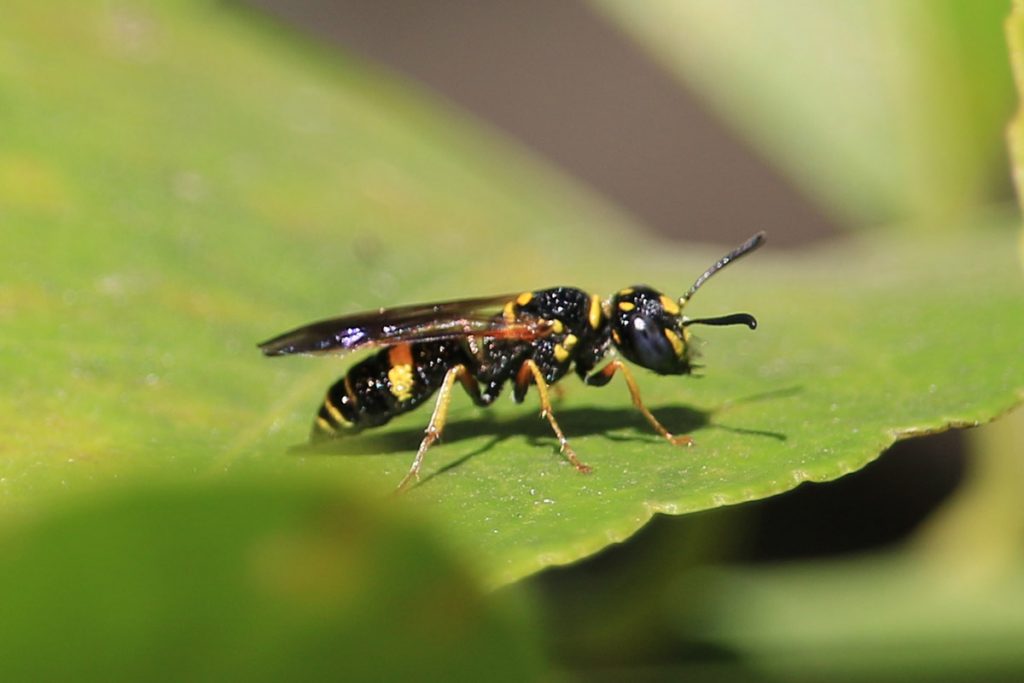
Speaking of hard to love, here’s a wasp that hunts bees. It’s been hanging out on our Meyer lemon tree for the last couple of weeks, and that tree has a couple of flowers. Like other solitary wasps, it is a pollinator. It’s their larvae that eat insects, which is why you see wasps killing caterpillars. I let this beewolf be; it’s a part of our natural diversity with its own niche to fill.
Since I took this photo, many of us have read about the invasive mass bee murdering “murder hornet,” which has entered our country. Ugh. I’ll take the beewolf over that any day.
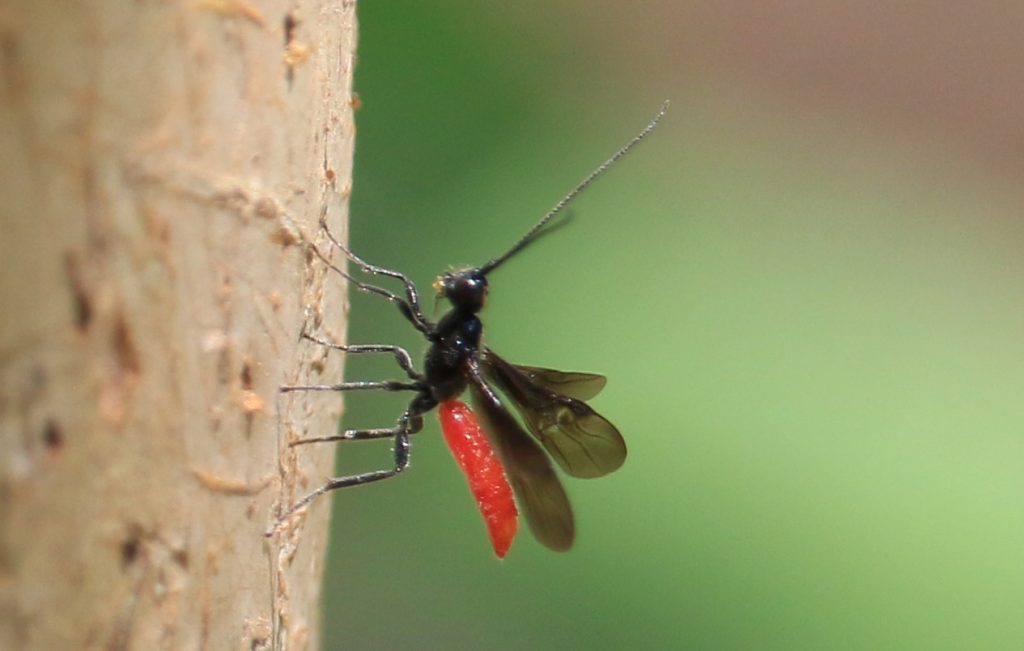
Braconid wasps, genus Atanycolus (maybe)
If my initial ID is correct, then here’s a much more palatable murderous wasp. Braconids are parasitic wasps. They parasitize a wide range of garden pests, from hornworms to stinkbugs. According to Bugguide, this genus lays their eggs in woodboring beetles and longhorn beetles, which both eat decaying wood. When the eggs hatch, the larvae devour their host.
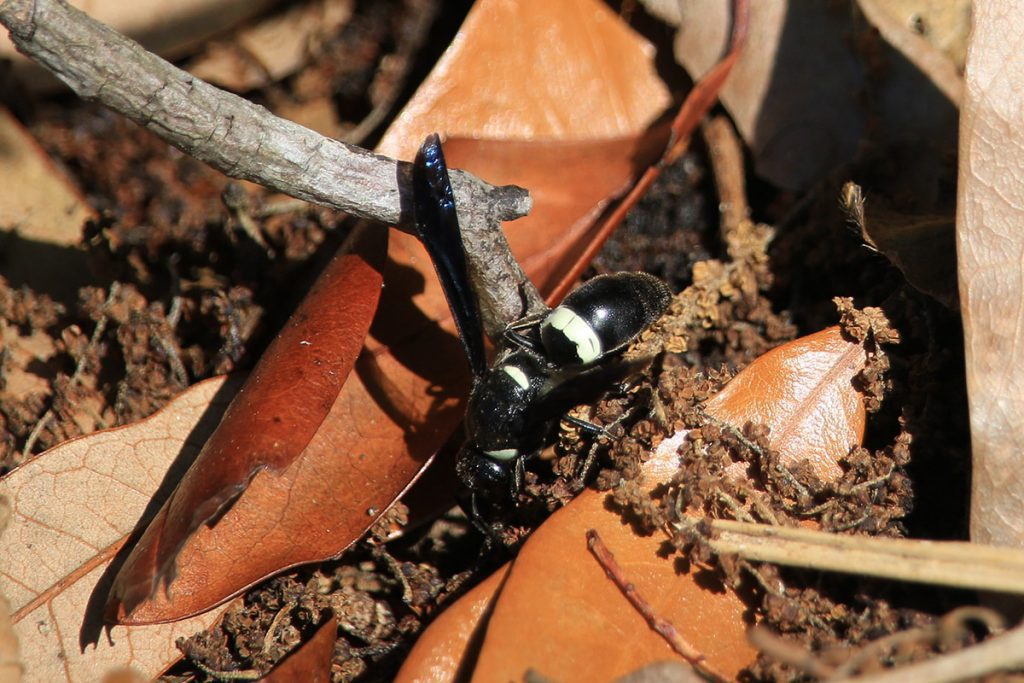
Four-toothed mason wasp
This species has been conspicuous in our yard over the last couple of years.
Lately, I’ve been seeing wasps of different species pecking at patches of bare earth. Are they hunting for insects to take back to the nest? Or, perhaps they are collecting soil to make their nests. This might be true of the red-marked pachodynerus wasp I saw pecking the dirt in March. Those have been nesting in bee house tubes, which they seal with earth.
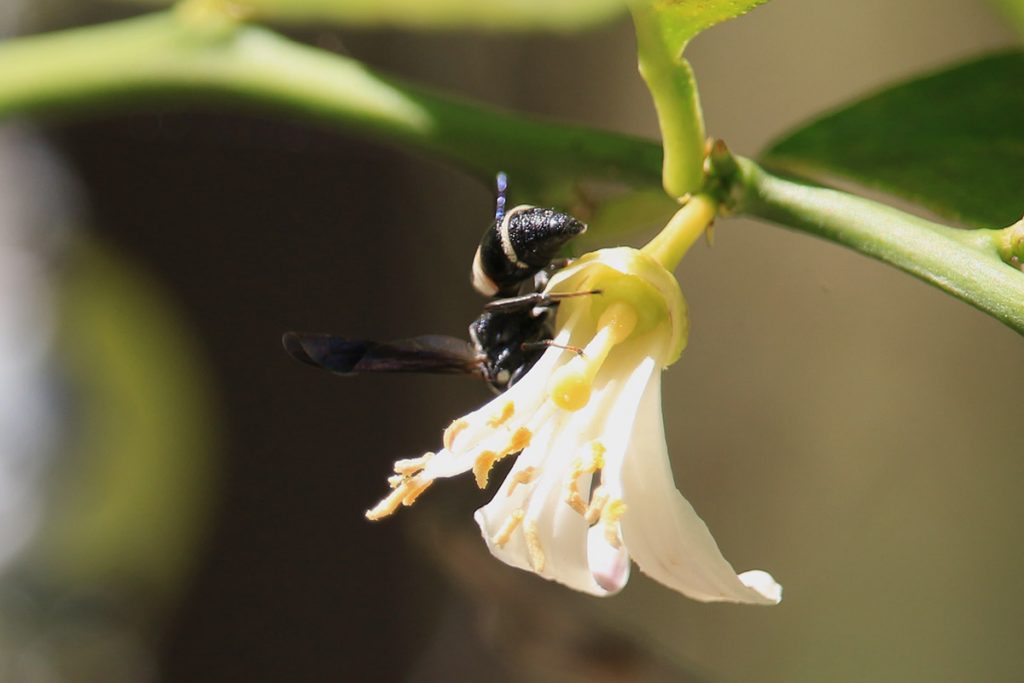
Four-toothed mason wasps make use of nests made by other wasps and bees. In our yard, they use abandoned carpenter bee nests, which are usually in fence posts. That work put in by the carpenters ends up supporting at least three species of pollinators, including the bees themselves.
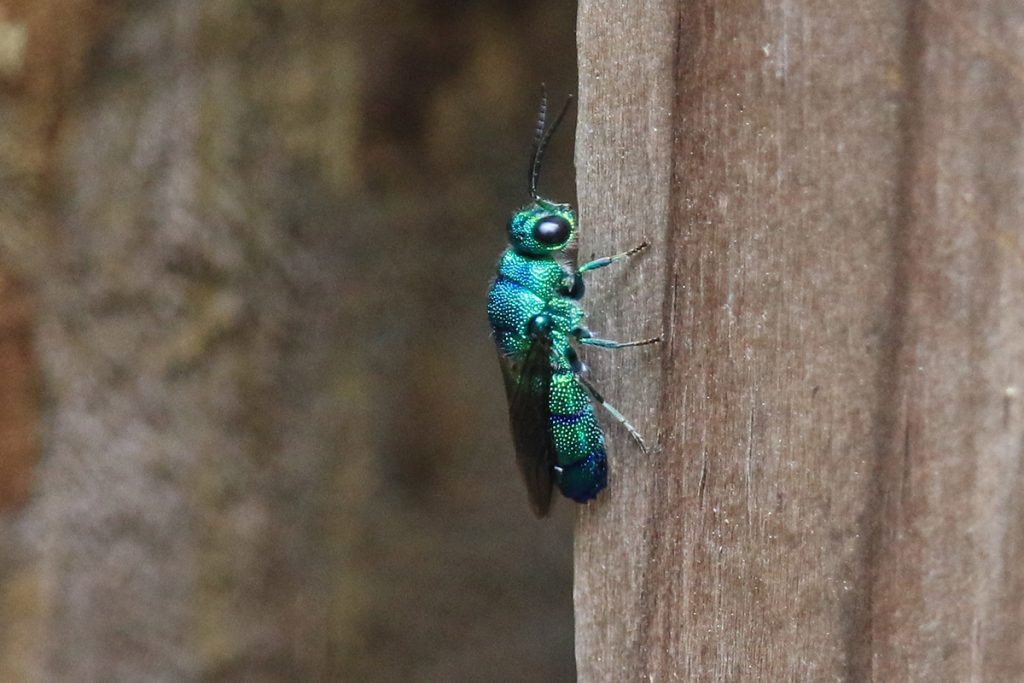
Cuckoo Wasps
Here’s a relationship I’ve been observing in our yard since I started the Backyard Blog in 2018. Cuckoo wasps lay their eggs in the nests of other wasps, and I always see them entering four-toothed mason wasp nests. The one above was hanging out just next to one. Its larvae may end up eating those of the other wasp.
I’ve seen plenty of both species in the yard, so cuckoo wasps haven’t wiped out the four-toothed masons.
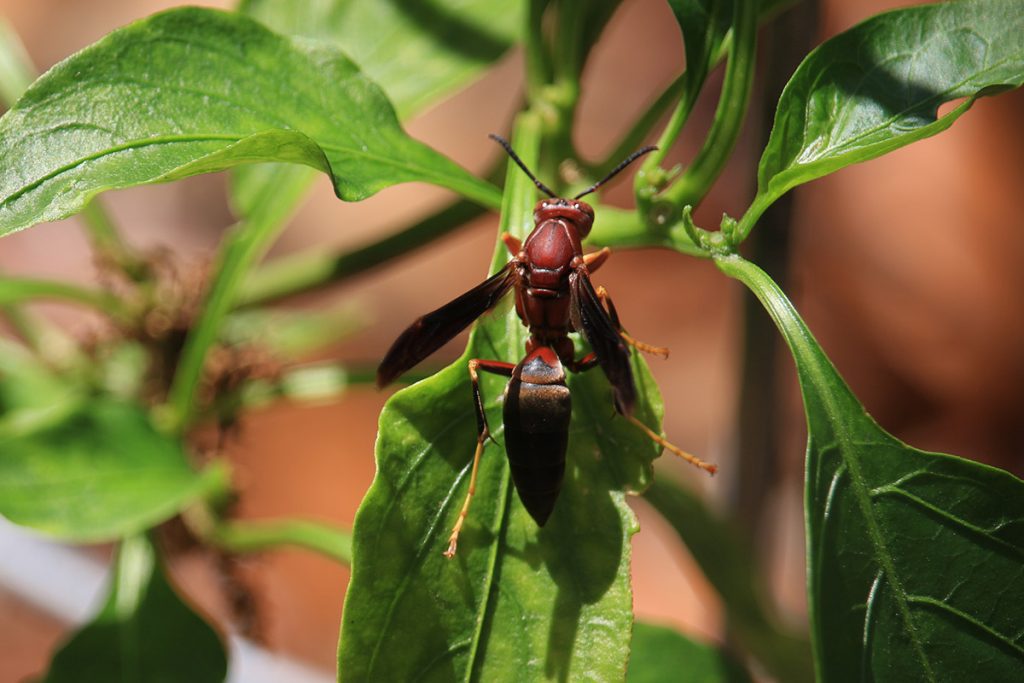
Metric Paper Wasp
Above is a large, scary, caterpillar hunting wasp. And it’s on a plant I don’t want eaten by caterpillars. Carry on, Polistes metricus.
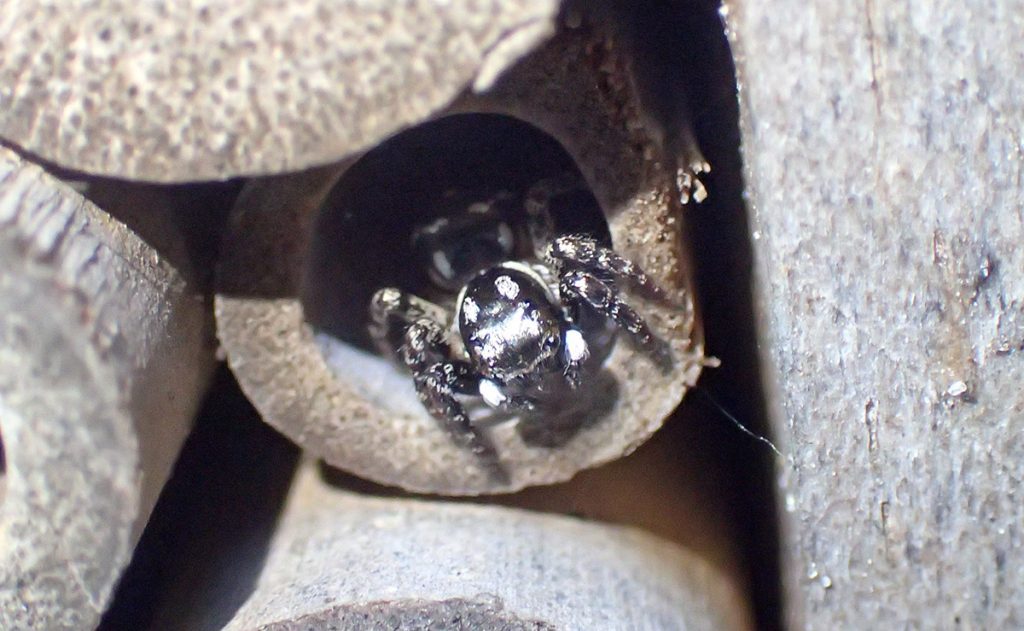
This isn’t a wasp, of course, but it’s in a bee nest tube adjacent to where the red-marked pachodynerus wasps have nests. I’ll have photos of those in the May post; as I’ve been writing this, I’ve seen what looks like parent/ newly hatched adult interaction. I do wonder if this spider got to any larvae, though.
Pollinators Part 4: Moths
I’m not great at moth ID, so I’ll post a couple of photos with my initial iNaturalist IDs. No one has confirmed them. There really are very many brown and white moths.
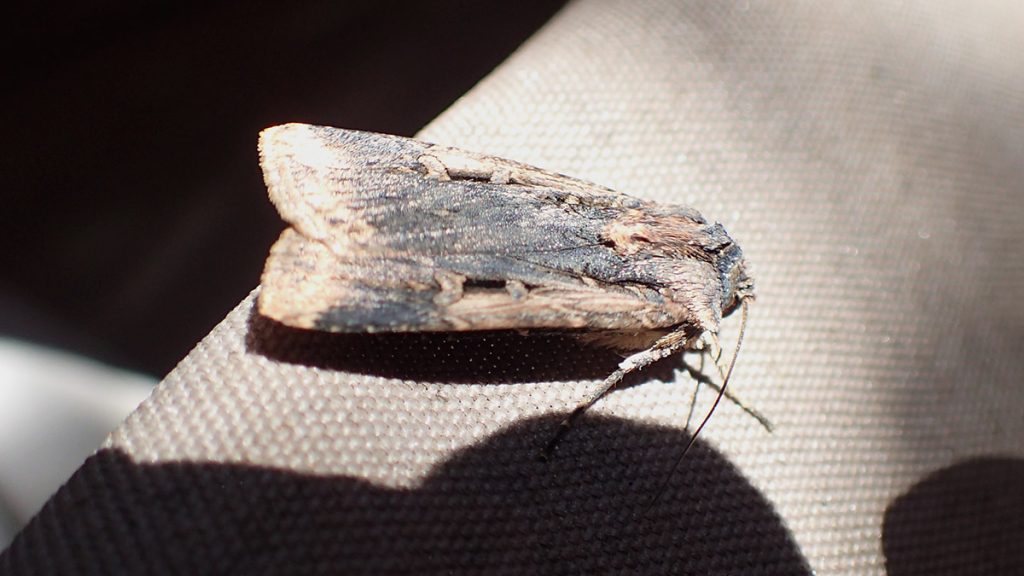
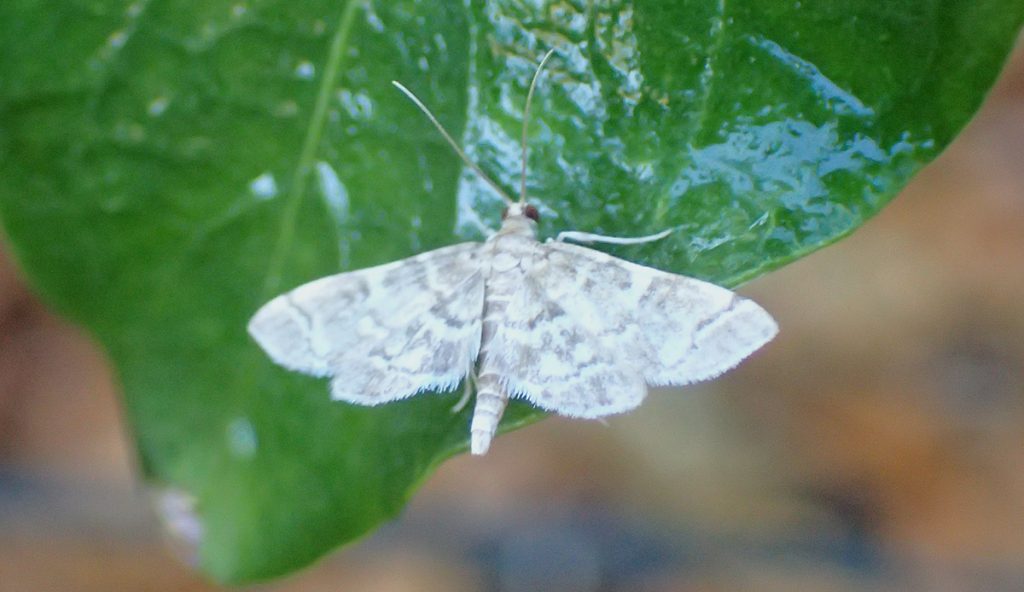
Using the compare button, I didn’t feel comfortable with the “pearl moths” ID.
Pollinators Part 5: Hoverflies
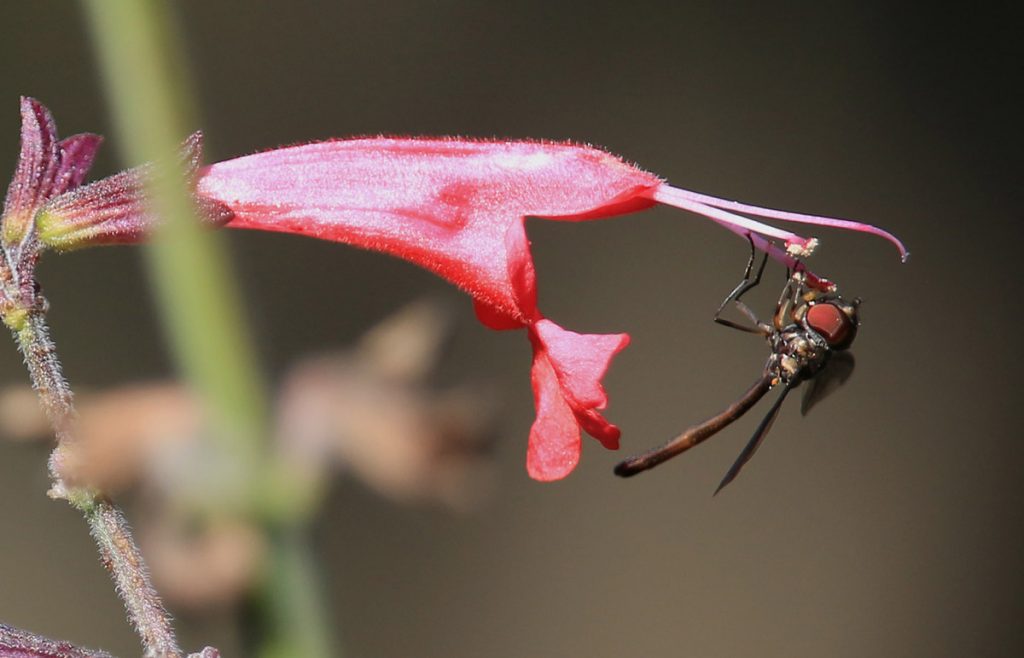
This is the third hoverfly species I’ve seen in the yard this year. Here it is hovering:
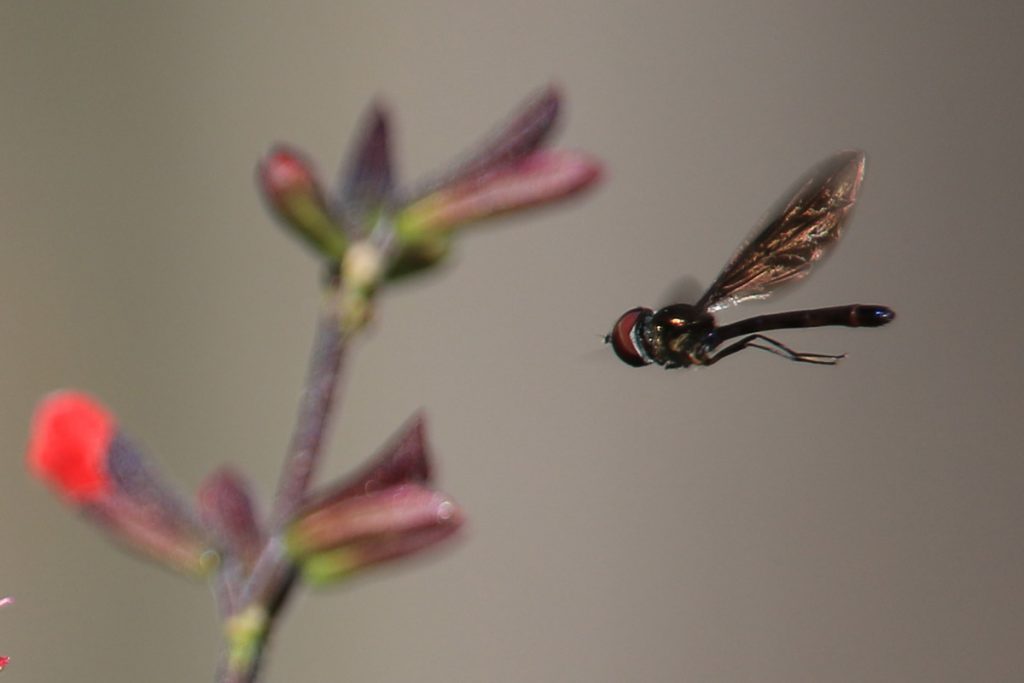
Again, hoverflies, or syrphids, are pollinating bee mimics whose larvae eat aphids. They are always welcome in the garden.
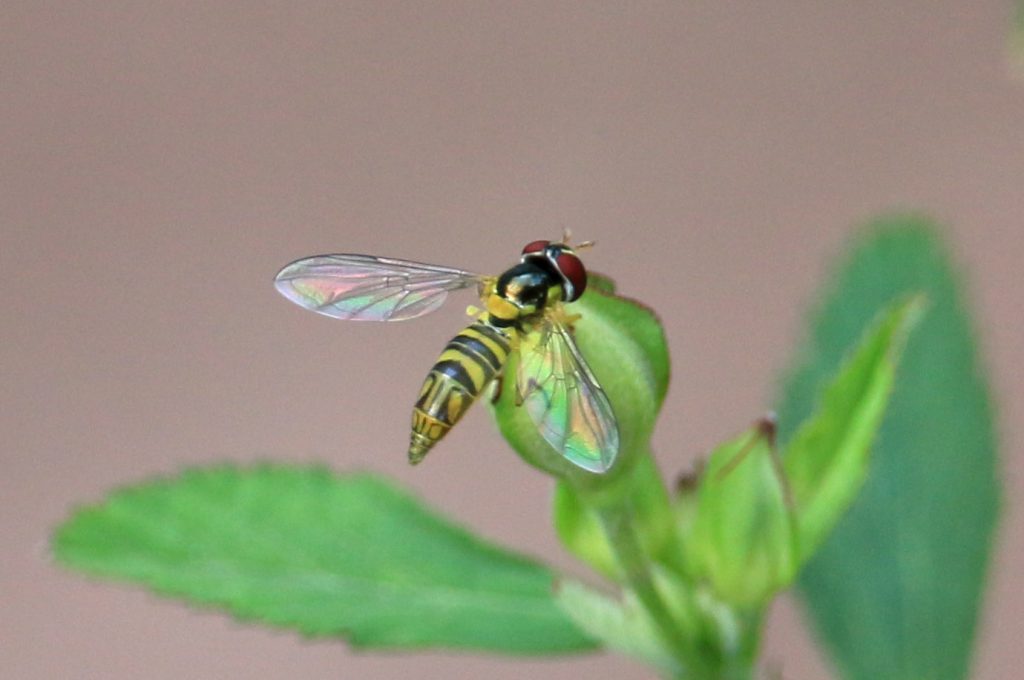
I shared photos of an oblique stripetail last month. Here, I think we get a better look at the markings on its abdomen.
Other fly species in the yard
I’ve spent a little more time this month reading about the different fly species I’ve been finding. So far in this post, we’ve seen two species of pollinating hoverflies, and the black soldier fly, whose larvae helps make my table scraps into compost. Who else do we have in our garden?
Long-legged flies
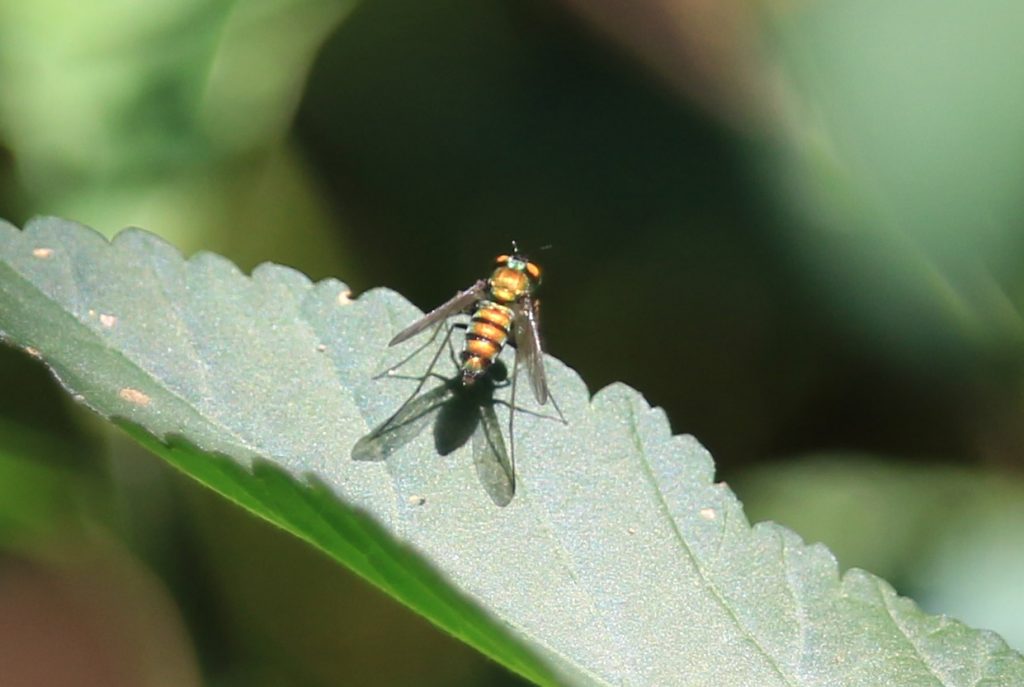
Long legged flies are predators, known for eating aphids and other garden pests. Pests is a subjective term, of course. Long-tailed skipper and giant swallowtail caterpillars eat our food plants, but I like the butterflies they become. And I plant milkweed and Apiaceae (carrot family) for monarchs and black swallowtails, respectively. When wasps cary off anonymous green moth caterpillars from our plants, they’re beneficial insects. But we’re horrified when they carry off monarch caterpillars, or, a thing I once filmed, skin a black swallowtail caterpillar and fly off with it.
Anyhow, much like wolves in the wild, insect predators keep our plant eaters in check.
Stilt-legged flies
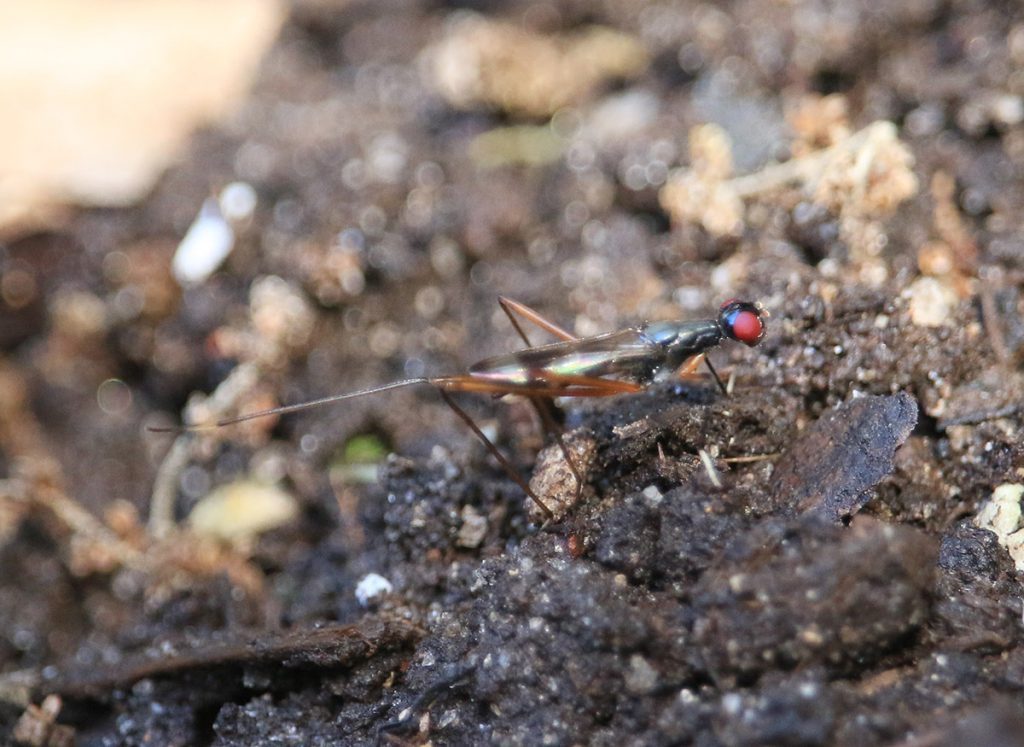
I’m pretty sure this is Rainieria antennaepes, a wasp mimic. According to its iNaturalist entry, it eats bird droppings, detritus, and other waste. Here’s another insect who does important work, eating the gross things. Some insects eat plants, others eat insects. But quite a lot of them eat fallen leaves, poop, decomposing wood- dead and dying organic matter. They are nature’s recyclers.
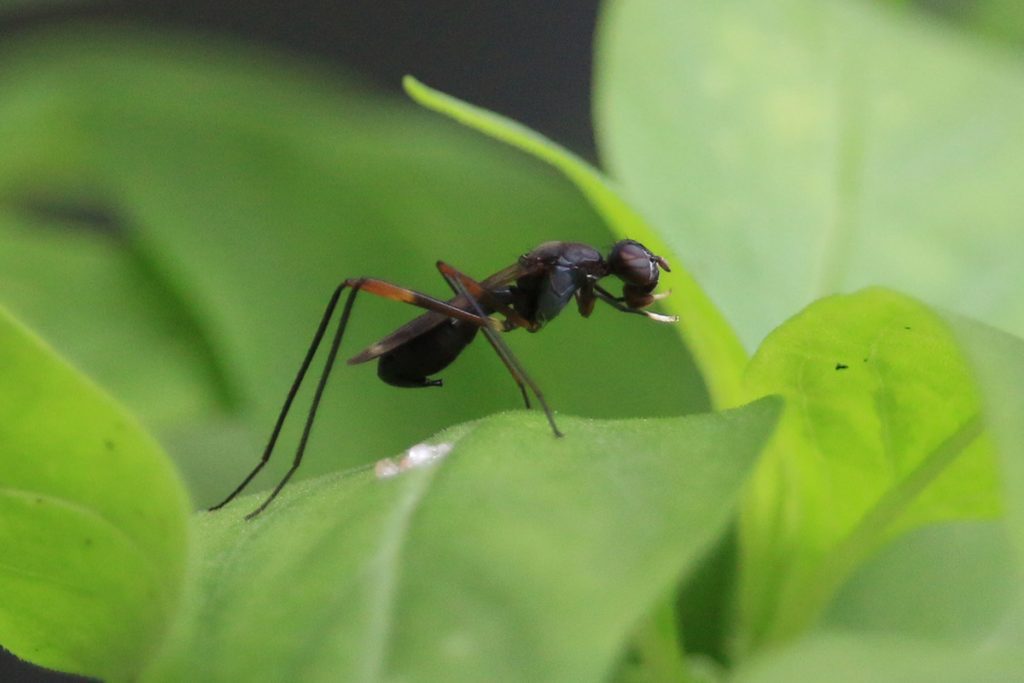
This, I think, is a related species in the Micropezidae family. Members of this family are known to eat dung or rotting fruit. This might be another compost helper.
Flesh Flies
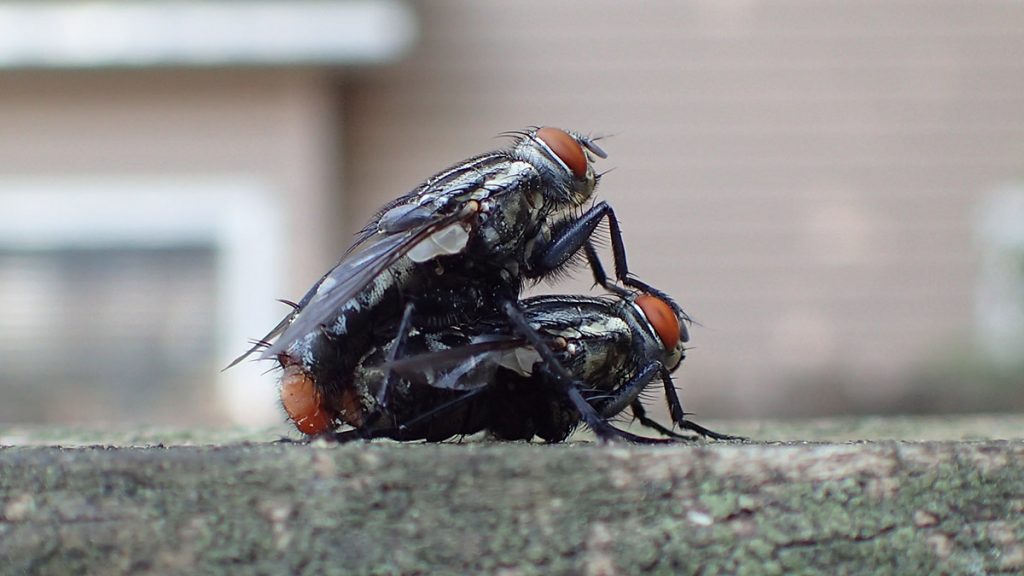
These are flesh flies, which eat decomposing animals and animal waste. Our dog passed a couple of months ago, so we don’t have the poop we used to. And we definitely don’t compost meat. But who knows what small critter met an end in the yards around ours? Or maybe they just liked this romantic spot in our yard.
Beetles
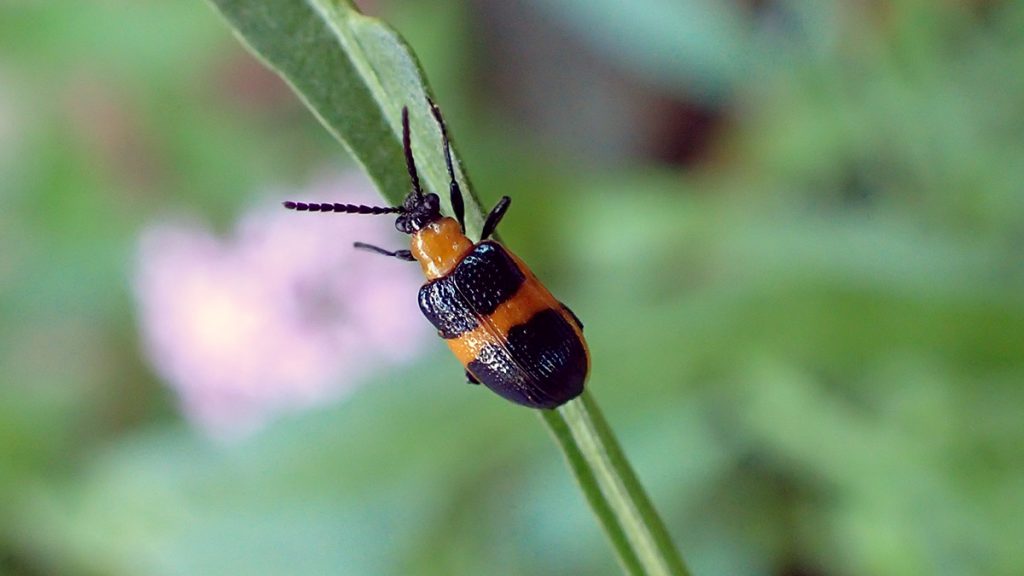
This one has been tough to identify. My first iNaturalist guess was a beetle in the genus Dicranolaius. Revisiting this observation after I first made uploaded it, I saw Leon County had a second identification of this genus with a photo of what looked like the same insect. Other than that ID and mine, the rest were in Australia. I also had a friend post a photo of a similar beetle on Facebook, just last week, and no once could identify it.
In the days since I started writing this, someone left a comment on that Facebook post, saying an iNaturalist user recommended Lema solani, a shining leaf beetle. These eat nightshades, and I have been letting native nightshade plants grow in the yard. This seems right.
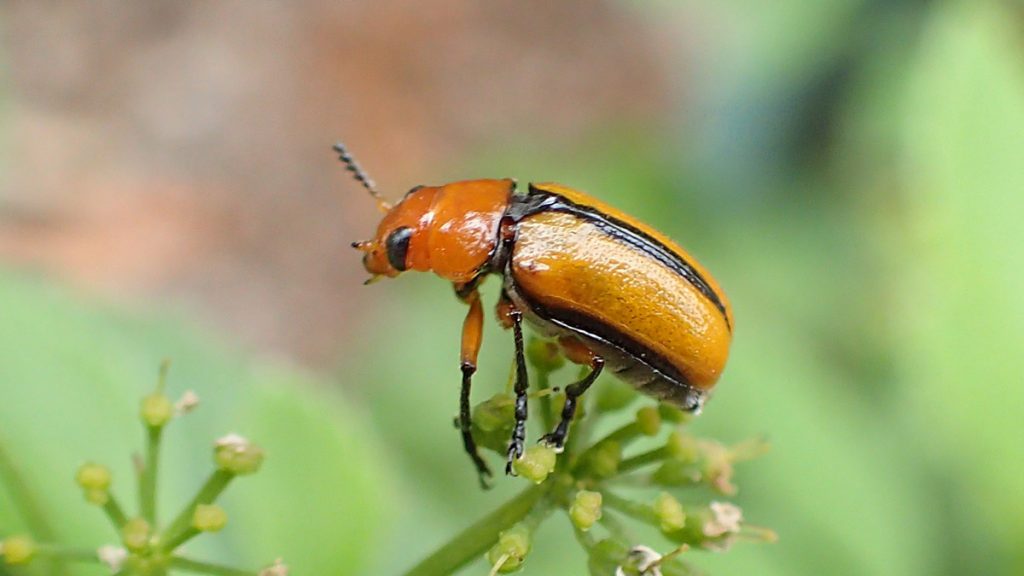
I think this is a clay colored beetle. It feeds on Fabaceae– legumes and beans. Could this be making holes in my bean plants? Or, hopefully, it’s merely eating the vetch growing everywhere in the yard.
Other Insects
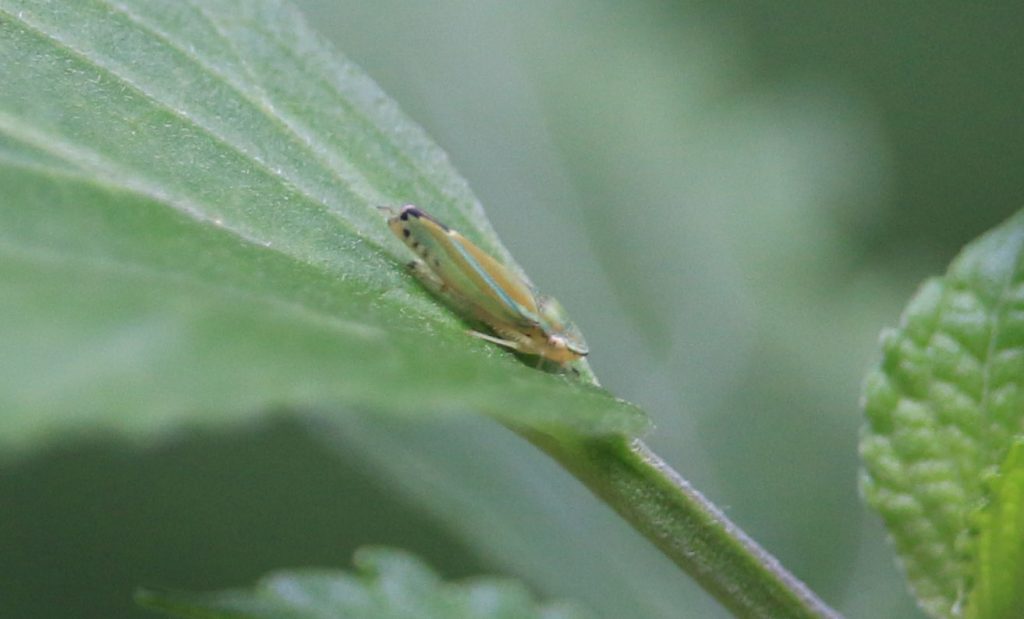
Leafhoppers are considered a garden pest. Aside from eating plants, they’re known to transmit harmful pathogens between plants, helping them spread.
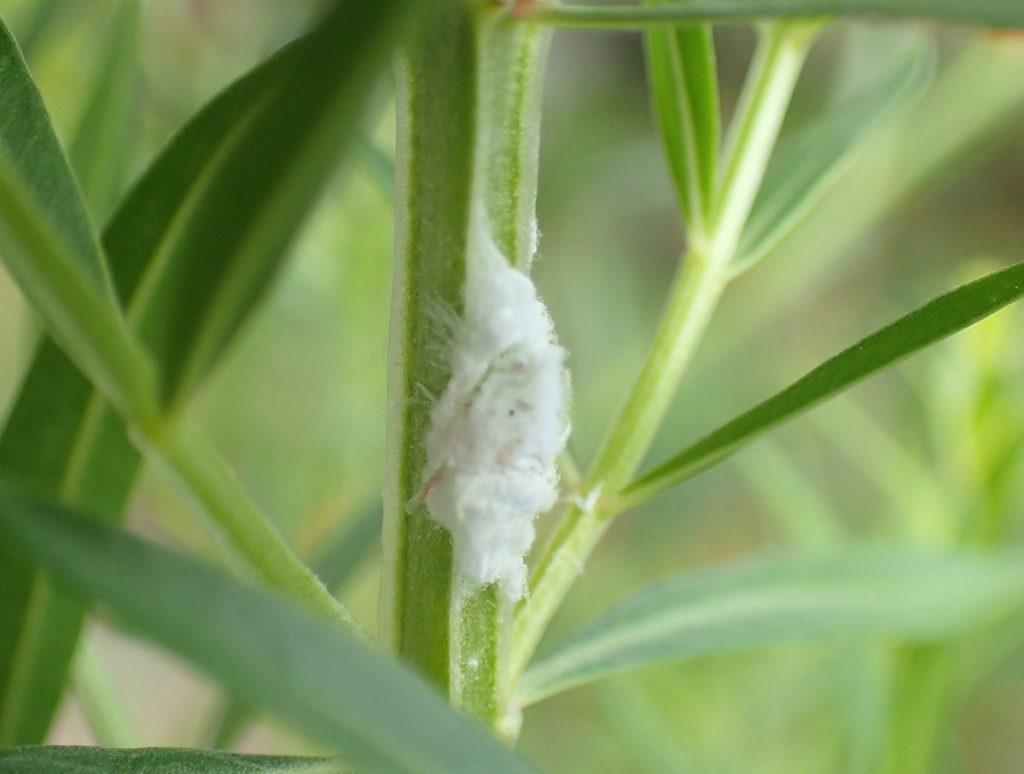
Mostly, white fuzzy things on your plants aren’t good. Edit May 24, 2021– I think this may be a lacewing larva. Lacewings are beneficial, predatory insects.
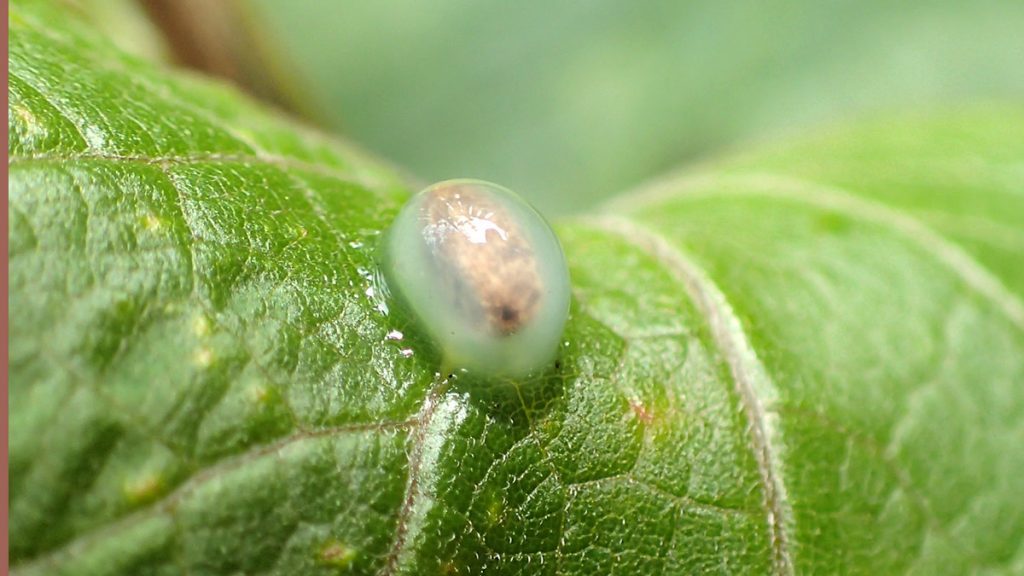
I have no idea what this is. Kinda neat, though. Edit May 24, 2021– Originally I took a wild stab at a guess on iNaturalist, that this was some sort of beetle larva. A biologist looked into it and was interested by it, but also had no idea. He tagged other biologists, who, again, also had no idea. After some back and forth with them, he wrote, “Thank you very much for looking. Filed under ‘strange and wondrous’ then for now.”
That’s why I find iNaturalist, and photographing every little weird thing I see, to be so much fun.
Also, lovebugs are back, it seems:
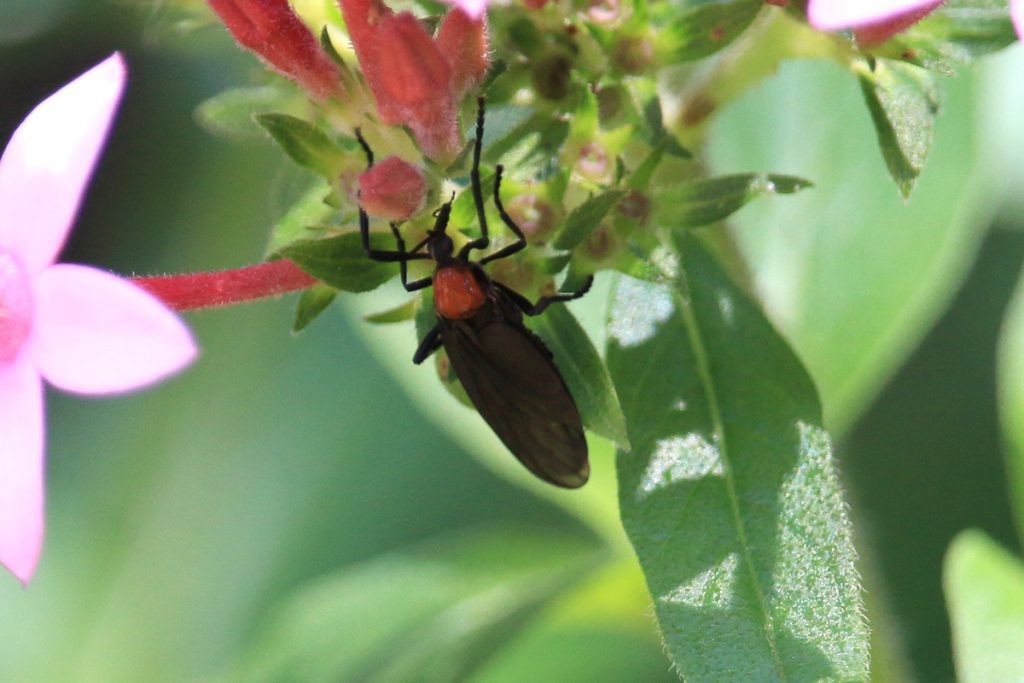
Birds in the Yard
New Fledgelings
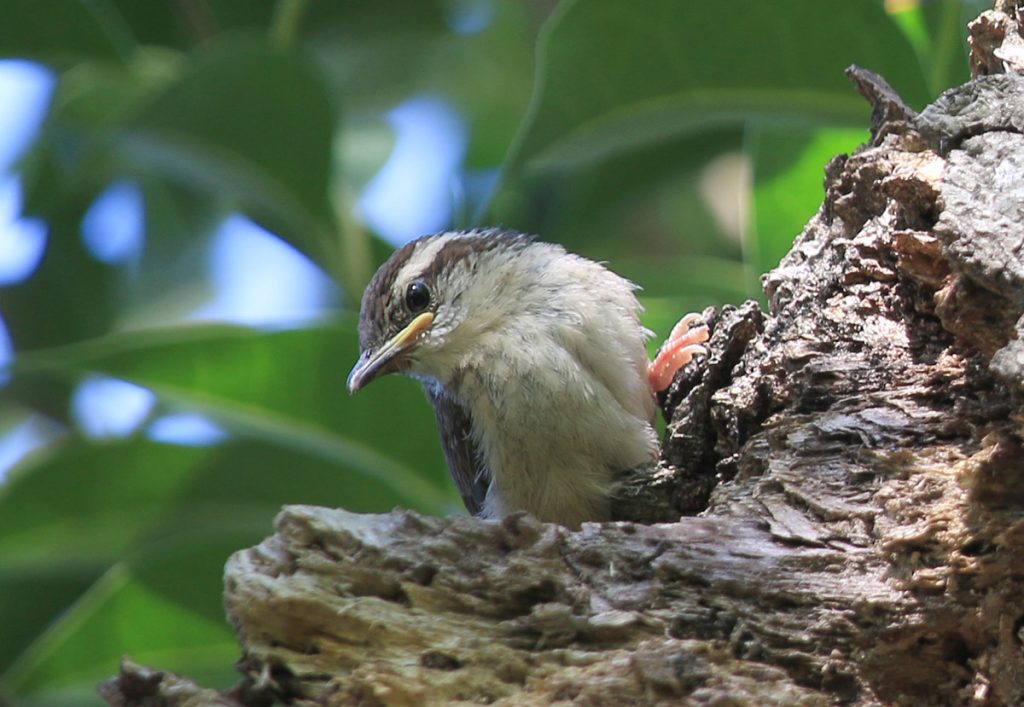
We have so many cool insects, I saved the cute birds for last(ish). If I didn’t have all of those insects in the yard, what would these guys eat, anyway?
One night, I was tucking my sons in. The cat sleeps in their room sometimes, but on this night, she was attacking Max’s window. We opened his curtain to see one of the wrens we’d been keeping an eye on in their porch nest. It had flown up on the window sill. Newly fledged birds sometimes fly up to a place and get stuck for a little while. They’re still learning. So despite the attacks from the other side of the window, it didn’t move. Kitty had to go to another room.
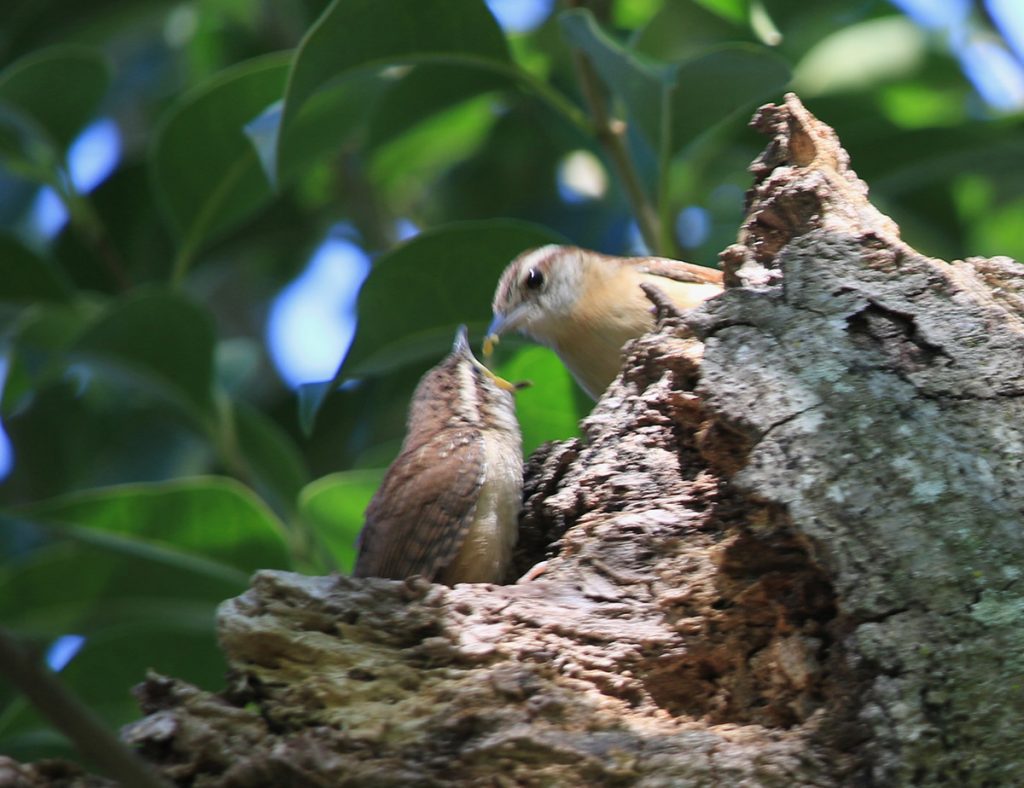
The next day, I could hear the wrens moving around our laurel oak. I got this quick pic of a parent feeding one of them up there.
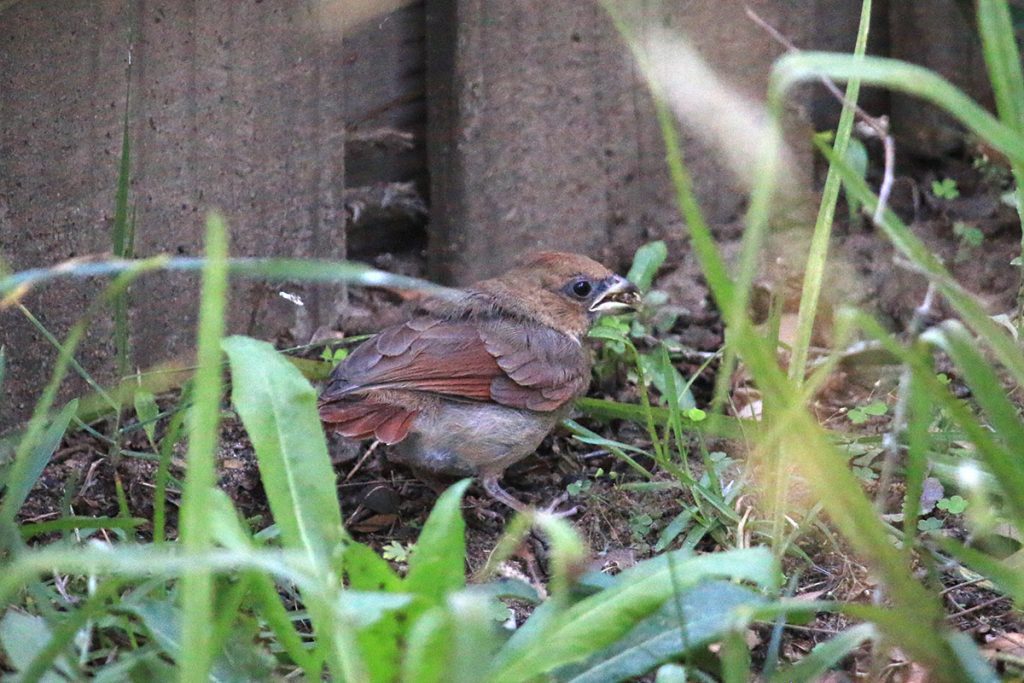
It’s sweet the way parents guide their newly fledged chicks around, and feed them. I saw a male and female cardinal with this fledgeling. It was pecking around an area of the yard I let grow, next to our biggest flower patch (which is spreading a little). I unwittingly scared four wrens from this spot right a week or two before this. It appears to be a haven for insect life, and so birds are often pecking around here. You can kind of see that this youngster has something in its beak.
As I was photographing it, its parents flew off. It didn’t move, perhaps unsure whether it could clear the fence. So I left, and the parents flew back to it. When I checked back a little while later, they were all gone, and I have since seen the fledgling as it continues to grow. It’s important when observing wildlife to not do anything to endanger it, and that includes not scaring parents away from their young.
A late-leaving winter migrant
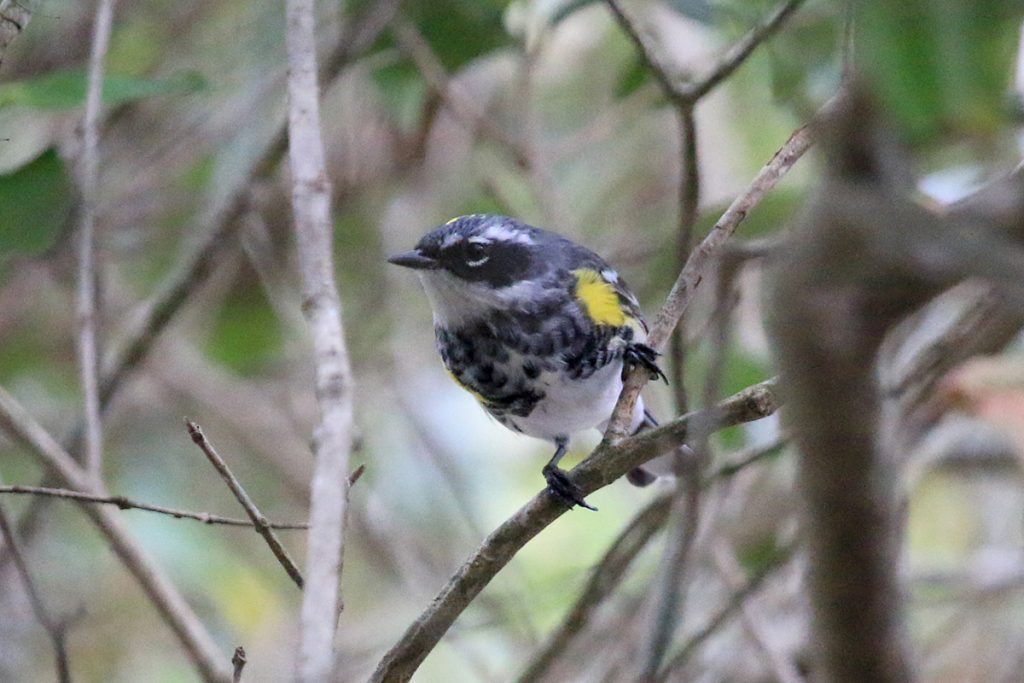
Here’s a bird I often see in the yard during the winter months. Like many winter visitors, it has a duller plumage when it migrates south. Here, it’s flashing bright yellows and a bolder overall pattern. This is its summer breeding plumage. Consulting eBird’s species map for yellow-rumped warblers, they don’t typically stay in our area past mid April. Here, in early April, it’s ready to fly north and nest.
A couple of new native species bloom in the yard
Early last year, I pulled a bunch of pavers off of a section of yard, and nature has slowly been reclaiming it (with a little help from me).
I have one new “weed” in this part of the yard, and one of last year’s natives has returned. Last year, nonnative chamber bitter and asthma plants were everywhere here. This year, I’m pulling every one of those as soon as I see them. Luckily, the native Carolina ponysfoot has covered a lot of ground, and I’m letting native geraniums and spiderworts go crazy. Also, the fogfruit and sensitive plants I’ve planted are starting to spread. So there’s more competition for nonnative plants as they try to establish themselves in the yard.
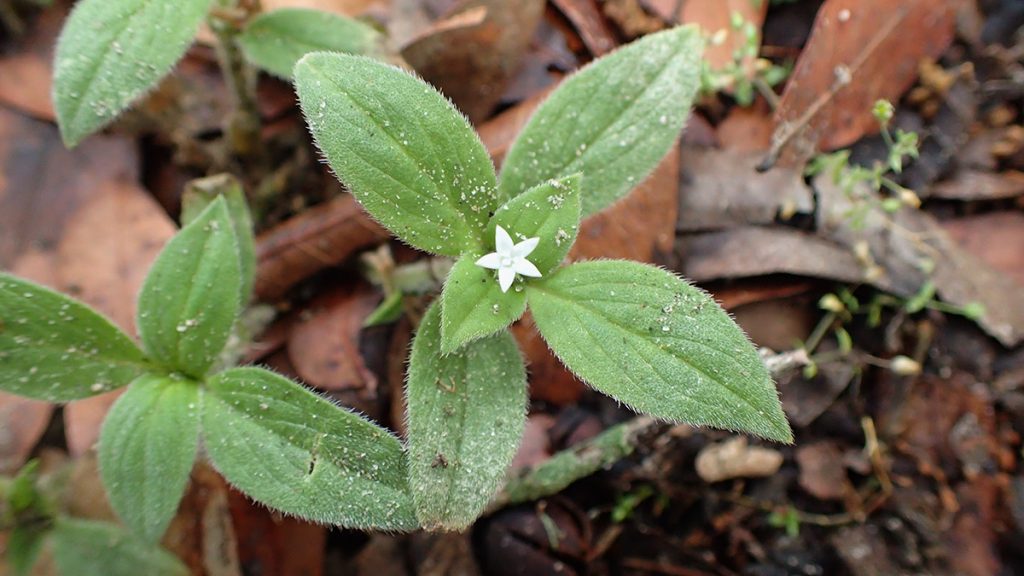
Another native groundcover plant started reappearing April: Florida pusley. I’ve had fun reading IFAS blog post comments about this one. Some people love how bees love the flowers. One person complained that there were too many bees. Some folks don’t like the way it spreads- it can take over. Others were asking for seeds, and were chastised because the plants might take over neighboring yards.
It’s not too aggressive in my yard, and it is a native. I’ll note that the flower above has five petals, and this plant typically has six. After looking the plant up, I went back out and checked- the rest of our flowers do have six.
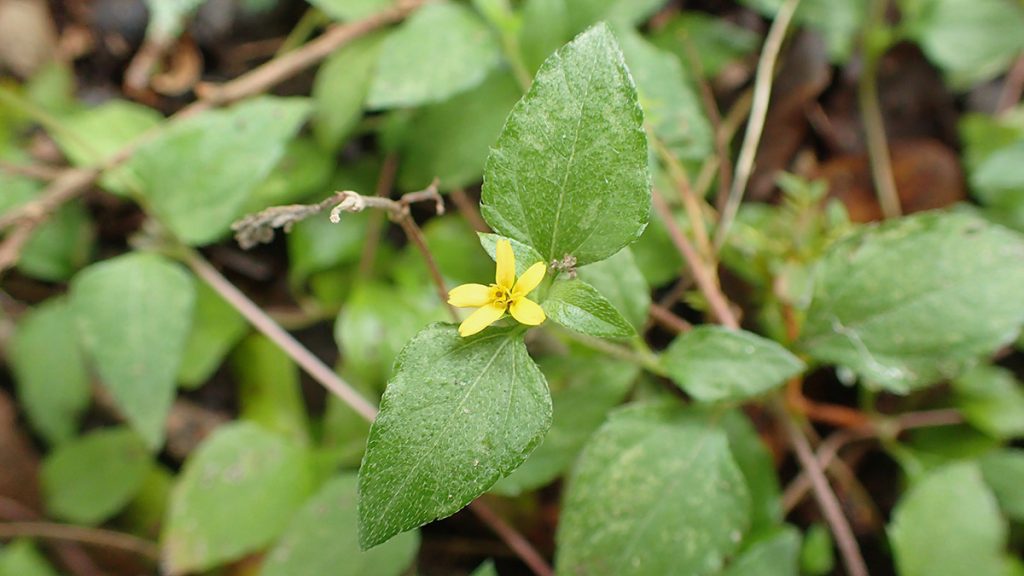
Here’s another native spreading out over parts of the yard. I don’t remember seeing it in our yard previously, so I’m happy to add a little diversity. Here you can get a sense of the flower size:
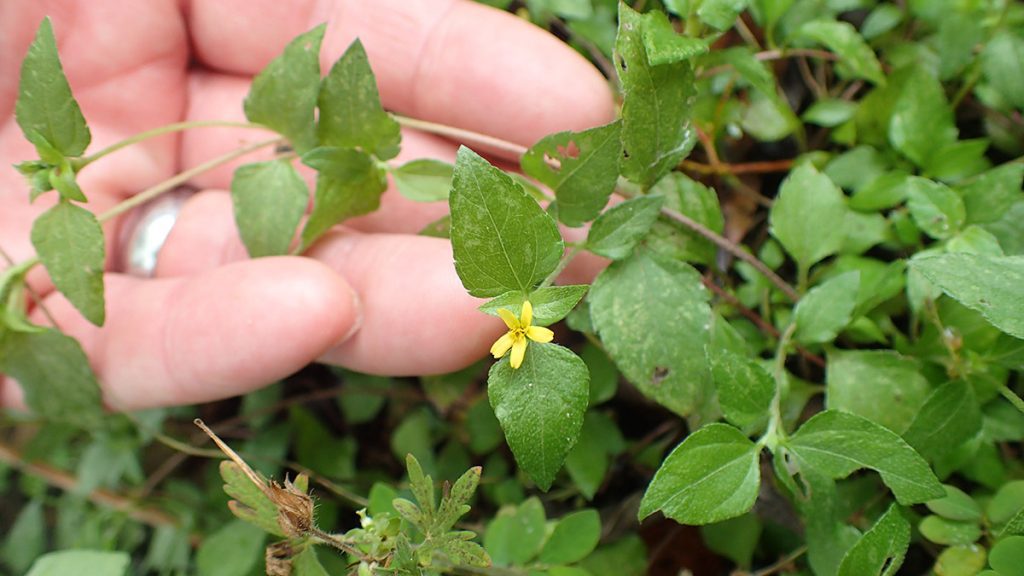
As usual, I take multiple photos of flowers for iNaturalist. I often upload one with my hand in it, for scale. And whenever you upload wildflower pics, make sure you include at least one where you can see the leaves.
As for the wildflowers I’ve planted, they seem close to ready. I can’t wait to see what May brings (I’ve already seen some cool stuff during the days I’ve been writing this).

Ironweed flower buds. 
Purple coneflower statring to bud. 
Turkey tangle fog fruit.
One more thing…
I just had to share this photo of an ill-fated strawberry in our yard.
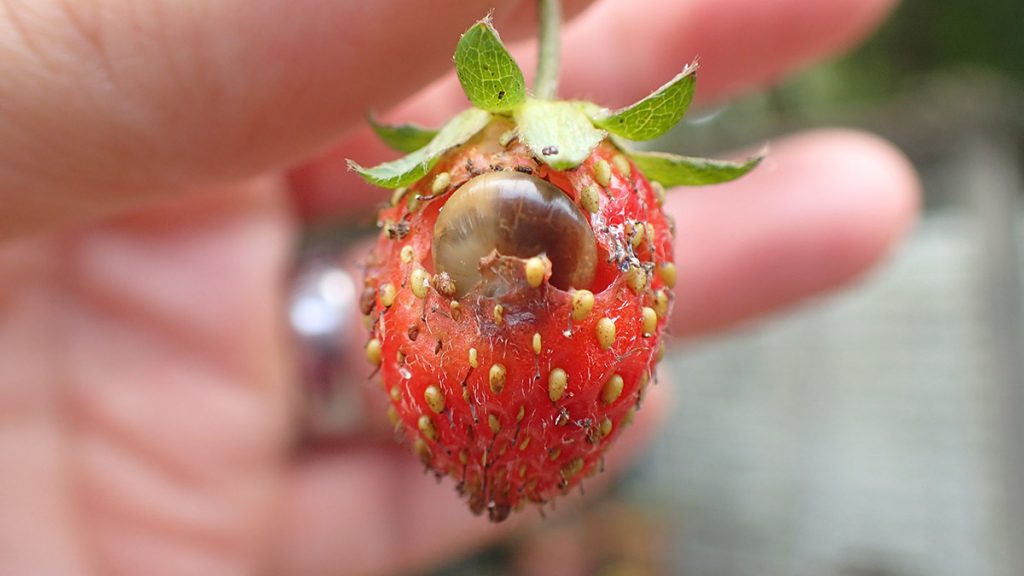
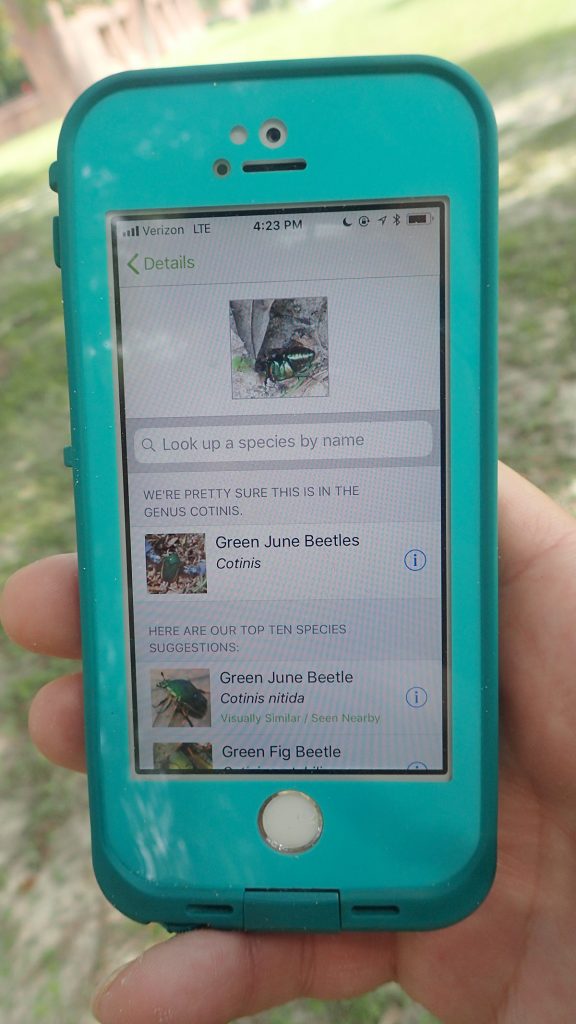
Apps and Citizen Science mentioned in the Backyard Blog
iNaturalist
Identify plants, animals, lichens, and fungi in your yard. Other users correct your identifications if you’re wrong, and even if they don’t, it can be a good springboard to further research.
Seek by iNaturalist
Instant identification, and it doesn’t record your location. This is a good option for kids with phones.
Monarch Larva Monitoring Project
Enter information about monarch caterpillars in your yard, and help researchers get a sense of the health of the monarch population that year, and how and when they’re migrating.
Great Sunflower Project
Record the number of pollinators visiting your flowers, and help researchers map pollinator activity across the country.
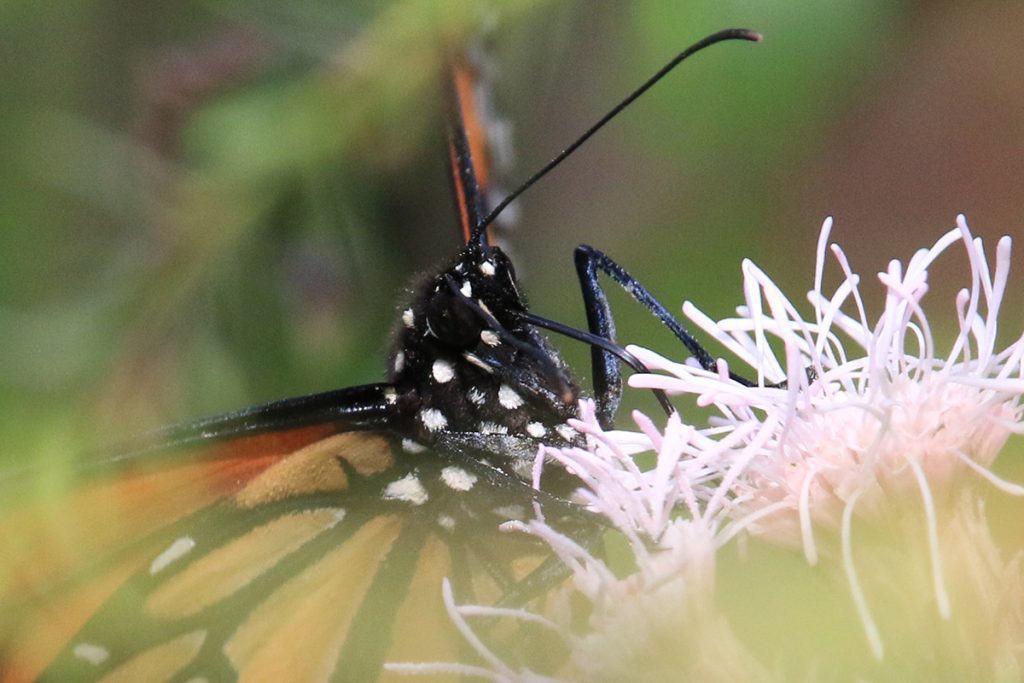
Dig Deeper into Backyard Ecology
What can we do to invite butterflies, birds, and other wildlife into our yards? And what about the flora and fauna that makes its way into our yards; the weeds, insects, and other critters that create the home ecosystem? WFSU Ecology Blog takes a closer look.


